Stan C. Smith's Blog, page 24
July 8, 2021
Awesome Animal - Kakapo
Thanks to reader (also one of my former 7th grade life science students) Scott Finley for suggesting this Awesome Animal.
Way back in 1995, Trish and I had a marvelous opportunity to travel to New Zealand. At a zoo there, we had our first introduction to the weird and wonderful kakapo (pronounced KAH-ke-poh), which is perhaps the most unusual of all parrots. These large parrots displayed endearing personalities, and we were immediately enamored by their appearance and antics. I think you'll find them just as fascinating as we do.

What the heck is a Kakapo?
For one thing, the kakapo is nocturnal—the only nocturnal parrot. And it is flightless—the only flightless parrot. Kakapos are massive, nine-pound parrots—the world's heaviest parrot. They spend their nights waddling around on the forest floor and climbing trees to find their favorite fruits and seeds. To top it all off, the kakapo might be the world's longest-living bird, with some individuals living up to 100 years.
Kakapos are endemic to New Zealand, and unfortunately they are highly endangered. In fact, I suppose Trish and I were lucky to see them at all—when we were there in the mid 90s, only 51 individual kakapos remained. The number is now closer to 200, which is good, but the species' survival is still far from assured.
The photo below gives you an idea of the kakapo's size.

Amazing Facts about the Kakapo
A flightless parrot? Really? Yep, completely flightless. Although this is the only flightless parrot, other birds have also evolved to be flightless on oceanic islands where there are few predators. Historically, New Zealand had no large land predators, resulting in a variety of flightless birds that would otherwise be vulnerable, such as the kakapo, several species of kiwi, three species of penguins, the takahe, the weka, and several species of flightless teal (teal are a kind of duck). In addition, New Zealand was home to a variety of extinct flightless birds, including the huge, impressive moas, which were the tallest birds known, able to reach foliage 12 feet (3.6 meters) off the ground. I guess you could say New Zealand is the flightless bird capital of the world.
Before humans arrived on New Zealand, the only predators kakapos had to worry about were birds of prey: one species of eagle, one falcon, one harrier, and one owl. Over time, the kakapo became well adapted to avoid these raptors—the parrots developed camouflaged feathers and became nocturnal. When kakapos feel threatened, they freeze, which helps them blend in with their surroundings. Although the eagle, falcon, and harrier only hunt in daylight, the nocturnal laughing owl could still sometimes prey on kakapos.
However, the real problems started when humans brought predatory mammals to New Zealand, particularly dogs, cats, and stoats (the short-tailed weasel).
Part of the problem is that a kakapo's body has a strong, musty-sweet smell (they use this smell to locate each other). This was not a problem when raptors were their only predators—raptors hunt by sight, not by smell. Mammal predators, on the other hand, have a highly developed sense of smell. Not a good thing for the kakapos! With mammals hunting them, the kakapo's tendency to freeze does not help at all and in fact makes them easy prey.
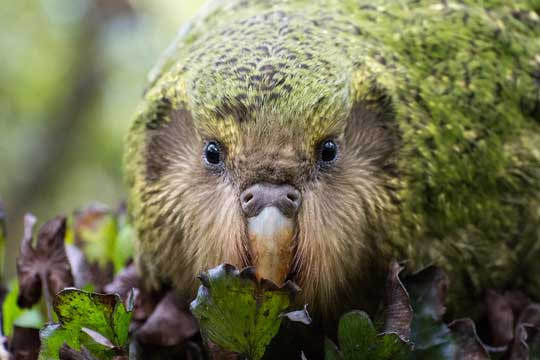
The Polynesian ancestors of the Māori (indigenous people of mainland New Zealand) arrived in New Zealand about 700 years ago, and they brought with them domesticated dogs called Kurī (a now-extinct breed of Polynesian dogs). The Māori used these dogs as a source of food, but they also used them to hunt birds, including the kakapo.
Also, the Māori inadvertently brought rats (as stowaways on their boats) to New Zealand, and the rats proliferated and preyed on kakapo eggs and chicks.
By the time Europeans arrived in 1642, the Māori had decimated the kakapo in some parts of New Zealand. Then, as I'm sure you can guess, the Europeans greatly accelerated the kakapo's decline. Not only did they clear vast tracts of land, they brought additional mammals, including different dogs, domestic cats, black rats, and stoats. By the late 1800s, the kakapo was recognized as a scientific curiosity, and thousands of them were killed and shipped to numerous museums around the world.
As I said above, when Trish and I saw these birds in a New Zealand zoo in 1995, there were only 51 individuals known to exist. Soon after that, all the remaining kakapos were transferred to four islands that had been cleared of all non-native predators and competitors, and were also replanted with native vegetation. Additional ongoing eradication efforts have been because cats, stoats, and rats continually reappear on the islands.
These protected kakapos have gradually increased to about 200 birds. Below is a Department of Conservation worker caring for some kakapo chicks.

Check out this video about the kakapo.
If you watched the video linked above, you saw a kakapo running toward the camera man, then stopping to take a closer look. Kakapos are notoriously friendly birds, and even those living wild on the protected islands are known to come right up to people, climb all over them, and even preen their hair. Of course, this friendly behavior has contributed to their decline, as they are extremely easy for humans and predators to hunt. In addition to hunting and eating kapakos, both the Māori and early European settlers kept these birds as pets.
Let's finish this up with a bit about the kakapo's sex life, which is just as unusual as all their other characteristics. Kakapos are the only parrots to have a a polygynous lek breeding system. That's a mouthful, so let's break it down. Polygynous means that one male mates with numerous females, but those females only mate with the one male. A lek is when a group of males gather in one area to compete for females by carrying out elaborate displays and behaviors. Females pick out their preferred males as the males display, or lek.
Amazingly, mating occurs only once every five years! This coincides with the ripening of a specific type of conifer seed called the rimu fruit, which kakapos love to eat. When it is finally time, the males will walk (remember, they can't fly!) up to four miles (6.4 km) to get to the lekking arena. At the arena, before the females arrive, the males fight aggressively for the best locations within the arena (each location is called a court). The most dominant males get the best courts.
Each court is a bowl-shaped depression in the ground, previously dug by male kakapos. The court bowls are usually situated near large rocks, a dirt bank, or tree roots that act to amplify sound. Why? Because the male kakapos make a lot of noise to impress the females. In fact, males make a loud booming sound all night long (about 8 hours non-stop), every night for a four-month period of time! The booms can be heard up to 3.1 miles (5 kilometers) away. This is such exhausting work that the males often loose 50% of their body weight during these four months (now you see why they only do this when abundant rimu fruits are ripe). As you can imagine, this booming activity can attract non-native predators from a long distance. Darn those non-native predators!
Once a female approaches a male's court, he performs an elaborate dance to impress her. Once they mate, the female heads back to her own territory, and the male keeps right on booming, hoping to mate with as many additional females as possible.
Females don't even reach sexual maturity until about nine years of age, and they only breed once every five years, so the kakapo is one of the slowest-breeding birds. This is why conservation efforts to increase the population have been so slow.
Below is a kakapo chick.

So, the Kakapo deserves a place in the N.A.H.O.F.
(Neat Animal Hall of Fame).
FUN FACT: The word neat originated in the 1540s, and it meant "clean, free from dirt." Originally it came from the Latin nitidus, with the literal meaning "gleaming." In the 1570s, it took on the meaning "inclined to be tidy," and in the 1590s the meaning "in good order." In about 1800, it began to be used to describe liquor that was "straight, undiluted." Finally, starting in 1934, neat was being used to mean "very good, desirable." The slang variant "neato" appeared in the 1960s. Today, neat is often used as a whimsically outdated adjective (see the silly "neature walk" videos). How neat is that? That's pretty neat!
So, neat is another way to say awesome!
Photo Credits:
Kakapo on ground - "Kenneth' Strigops habroptilus (Kākāpō)" by TheyLookLikeUs is licensed under CC BY-NC-SA 2.0
Kakapo held by man - Errol Nye, National Kakapo Team, DOC. enye@doc.govt.nzUploaded by Ppgardne at en.wikipedia, CC BY-SA 3.0, via Wikimedia Commons
Kakapo hiding on the ground - "Hugh' Strigops habroptilus (Kākāpō)" by TheyLookLikeUs is licensed under CC BY-NC-SA 2.0
Kakapo chicks being fed - Department of Conservation, CC BY 2.0, via Wikimedia Commons
Kakapo chick - "K1', Strigops habroptilus (Kākāpō)" by TheyLookLikeUs is licensed under CC BY-NC-SA 2.0
Way back in 1995, Trish and I had a marvelous opportunity to travel to New Zealand. At a zoo there, we had our first introduction to the weird and wonderful kakapo (pronounced KAH-ke-poh), which is perhaps the most unusual of all parrots. These large parrots displayed endearing personalities, and we were immediately enamored by their appearance and antics. I think you'll find them just as fascinating as we do.

What the heck is a Kakapo?
For one thing, the kakapo is nocturnal—the only nocturnal parrot. And it is flightless—the only flightless parrot. Kakapos are massive, nine-pound parrots—the world's heaviest parrot. They spend their nights waddling around on the forest floor and climbing trees to find their favorite fruits and seeds. To top it all off, the kakapo might be the world's longest-living bird, with some individuals living up to 100 years.
Kakapos are endemic to New Zealand, and unfortunately they are highly endangered. In fact, I suppose Trish and I were lucky to see them at all—when we were there in the mid 90s, only 51 individual kakapos remained. The number is now closer to 200, which is good, but the species' survival is still far from assured.
The photo below gives you an idea of the kakapo's size.

Amazing Facts about the Kakapo
A flightless parrot? Really? Yep, completely flightless. Although this is the only flightless parrot, other birds have also evolved to be flightless on oceanic islands where there are few predators. Historically, New Zealand had no large land predators, resulting in a variety of flightless birds that would otherwise be vulnerable, such as the kakapo, several species of kiwi, three species of penguins, the takahe, the weka, and several species of flightless teal (teal are a kind of duck). In addition, New Zealand was home to a variety of extinct flightless birds, including the huge, impressive moas, which were the tallest birds known, able to reach foliage 12 feet (3.6 meters) off the ground. I guess you could say New Zealand is the flightless bird capital of the world.
Before humans arrived on New Zealand, the only predators kakapos had to worry about were birds of prey: one species of eagle, one falcon, one harrier, and one owl. Over time, the kakapo became well adapted to avoid these raptors—the parrots developed camouflaged feathers and became nocturnal. When kakapos feel threatened, they freeze, which helps them blend in with their surroundings. Although the eagle, falcon, and harrier only hunt in daylight, the nocturnal laughing owl could still sometimes prey on kakapos.
However, the real problems started when humans brought predatory mammals to New Zealand, particularly dogs, cats, and stoats (the short-tailed weasel).
Part of the problem is that a kakapo's body has a strong, musty-sweet smell (they use this smell to locate each other). This was not a problem when raptors were their only predators—raptors hunt by sight, not by smell. Mammal predators, on the other hand, have a highly developed sense of smell. Not a good thing for the kakapos! With mammals hunting them, the kakapo's tendency to freeze does not help at all and in fact makes them easy prey.

The Polynesian ancestors of the Māori (indigenous people of mainland New Zealand) arrived in New Zealand about 700 years ago, and they brought with them domesticated dogs called Kurī (a now-extinct breed of Polynesian dogs). The Māori used these dogs as a source of food, but they also used them to hunt birds, including the kakapo.
Also, the Māori inadvertently brought rats (as stowaways on their boats) to New Zealand, and the rats proliferated and preyed on kakapo eggs and chicks.
By the time Europeans arrived in 1642, the Māori had decimated the kakapo in some parts of New Zealand. Then, as I'm sure you can guess, the Europeans greatly accelerated the kakapo's decline. Not only did they clear vast tracts of land, they brought additional mammals, including different dogs, domestic cats, black rats, and stoats. By the late 1800s, the kakapo was recognized as a scientific curiosity, and thousands of them were killed and shipped to numerous museums around the world.
As I said above, when Trish and I saw these birds in a New Zealand zoo in 1995, there were only 51 individuals known to exist. Soon after that, all the remaining kakapos were transferred to four islands that had been cleared of all non-native predators and competitors, and were also replanted with native vegetation. Additional ongoing eradication efforts have been because cats, stoats, and rats continually reappear on the islands.
These protected kakapos have gradually increased to about 200 birds. Below is a Department of Conservation worker caring for some kakapo chicks.

Check out this video about the kakapo.
If you watched the video linked above, you saw a kakapo running toward the camera man, then stopping to take a closer look. Kakapos are notoriously friendly birds, and even those living wild on the protected islands are known to come right up to people, climb all over them, and even preen their hair. Of course, this friendly behavior has contributed to their decline, as they are extremely easy for humans and predators to hunt. In addition to hunting and eating kapakos, both the Māori and early European settlers kept these birds as pets.
Let's finish this up with a bit about the kakapo's sex life, which is just as unusual as all their other characteristics. Kakapos are the only parrots to have a a polygynous lek breeding system. That's a mouthful, so let's break it down. Polygynous means that one male mates with numerous females, but those females only mate with the one male. A lek is when a group of males gather in one area to compete for females by carrying out elaborate displays and behaviors. Females pick out their preferred males as the males display, or lek.
Amazingly, mating occurs only once every five years! This coincides with the ripening of a specific type of conifer seed called the rimu fruit, which kakapos love to eat. When it is finally time, the males will walk (remember, they can't fly!) up to four miles (6.4 km) to get to the lekking arena. At the arena, before the females arrive, the males fight aggressively for the best locations within the arena (each location is called a court). The most dominant males get the best courts.
Each court is a bowl-shaped depression in the ground, previously dug by male kakapos. The court bowls are usually situated near large rocks, a dirt bank, or tree roots that act to amplify sound. Why? Because the male kakapos make a lot of noise to impress the females. In fact, males make a loud booming sound all night long (about 8 hours non-stop), every night for a four-month period of time! The booms can be heard up to 3.1 miles (5 kilometers) away. This is such exhausting work that the males often loose 50% of their body weight during these four months (now you see why they only do this when abundant rimu fruits are ripe). As you can imagine, this booming activity can attract non-native predators from a long distance. Darn those non-native predators!
Once a female approaches a male's court, he performs an elaborate dance to impress her. Once they mate, the female heads back to her own territory, and the male keeps right on booming, hoping to mate with as many additional females as possible.
Females don't even reach sexual maturity until about nine years of age, and they only breed once every five years, so the kakapo is one of the slowest-breeding birds. This is why conservation efforts to increase the population have been so slow.
Below is a kakapo chick.

So, the Kakapo deserves a place in the N.A.H.O.F.
(Neat Animal Hall of Fame).
FUN FACT: The word neat originated in the 1540s, and it meant "clean, free from dirt." Originally it came from the Latin nitidus, with the literal meaning "gleaming." In the 1570s, it took on the meaning "inclined to be tidy," and in the 1590s the meaning "in good order." In about 1800, it began to be used to describe liquor that was "straight, undiluted." Finally, starting in 1934, neat was being used to mean "very good, desirable." The slang variant "neato" appeared in the 1960s. Today, neat is often used as a whimsically outdated adjective (see the silly "neature walk" videos). How neat is that? That's pretty neat!
So, neat is another way to say awesome!
Photo Credits:
Kakapo on ground - "Kenneth' Strigops habroptilus (Kākāpō)" by TheyLookLikeUs is licensed under CC BY-NC-SA 2.0
Kakapo held by man - Errol Nye, National Kakapo Team, DOC. enye@doc.govt.nzUploaded by Ppgardne at en.wikipedia, CC BY-SA 3.0, via Wikimedia Commons
Kakapo hiding on the ground - "Hugh' Strigops habroptilus (Kākāpō)" by TheyLookLikeUs is licensed under CC BY-NC-SA 2.0
Kakapo chicks being fed - Department of Conservation, CC BY 2.0, via Wikimedia Commons
Kakapo chick - "K1', Strigops habroptilus (Kākāpō)" by TheyLookLikeUs is licensed under CC BY-NC-SA 2.0
Published on July 08, 2021 07:40
June 21, 2021
Awesome Animal - Okapi
Imagine an animal that appears to be part zebra, part giraffe, and part donkey. Your imaginary creature might look something like an okapi. In fact, the okapi is sometimes called the zebra giraffe. In spite of its large size and distinct appearance, the okapi was not announced and described by western scientists until early in the 20th century. Why? Because they are reclusive and live only in the lowland forests of the Democratic Republic of Congo (in central Africa).

What the heck is an Okapi?
The okapi (pronounced oh-COP-ee) is not closely related to zebras. If you look at an okapi's head, you'll see that the general structure is similar to the head of a giraffe. In fact, okapis are the only living close relative of giraffes (in the family Giraffidae). In addition to the name zebra giraffe, it is also called the forest giraffe.
The okapi is an artiodactyl mammal (an ungulate that stands on two of its toes). They weigh from 440 to 770 pounds (200 to 350 kg) and stand about 5 feet (1.5 m) tall at the shoulder. Unfortunately, they are endangered, and their numbers have been reduced by half in the last 15 years.
Below you can see the resemblance between an okapi's head and a giraffe's head.
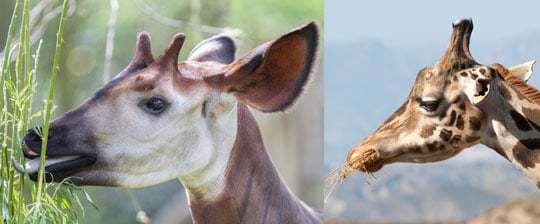
Amazing Facts about the Okapi
Did you notice the okapi in the first photo above does not have horns, but the one in the second photo does? That's because the first one is a female and the second is a male. Giraffes have these also. These short little horns are actually called ossicones. The weird thing is, only male okapis have ossicones, but both female and male giraffes have ossicones! Hmmm. What's up with that?
Have you ever watched a giraffe walk? Okapis and giraffes have a strange gait called a pacing gait—they step with both of the legs on one side of the body at the same time. So, they step forward with both the right legs, then step with both the left legs. All other ungulates walk by stepping forward with alternate legs on either side of the body. I know... it's hard to picture, isn't it? Check out this video of a giraffe's pacing gait.
Like giraffes, okapis have ridiculously long tongues. An okapi's tongue is 18 inches (46 cm) long! These creatures feed on understory plants in the forest, and this long tongue helps them select and pull off their favorite types of leaves. Also, the tongue is so long that they can use it to clean their eyes and even their ears. Below is an okapi grooming itself with its tongue.
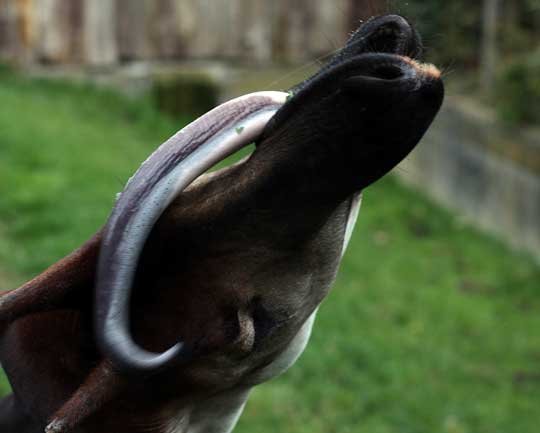
The okapi keeps this long tongue busy by eating all day. In fact, they eat up to 60 pounds (27 kg) of plant material every day. They must not be too picky, because they have been observed eating over 100 different types of plants, some of which are poisonous to humans and other animals. They eat clay from the riverbeds to replenish salt and minerals. They also eat charred wood from trees that have been struck by lightning (again, probably to get minerals). And, as if that weren't strange enough, okapis even snarf up bat excrement. Yummy.
Check out this video about Okapis
Okapis live most of their lives alone, although occasionally they will gather in groups to eat, to groom each other, and to play.
What about those weird, zebra-like stripes on their legs and rump? These may help camouflage the okapi in its forest habitat (leopards are a natural predator of okapis). My favorite explanation, though, is that these are the okapi's "follow-me stripes." Some people believe the stripes help baby okapis see and follow the adults through the dense forest. Hmm... these seem to me to be contradictory explanations—one says the stripes hide the okapi, one says the stripes make the okapi more visible. Which do you think it is?
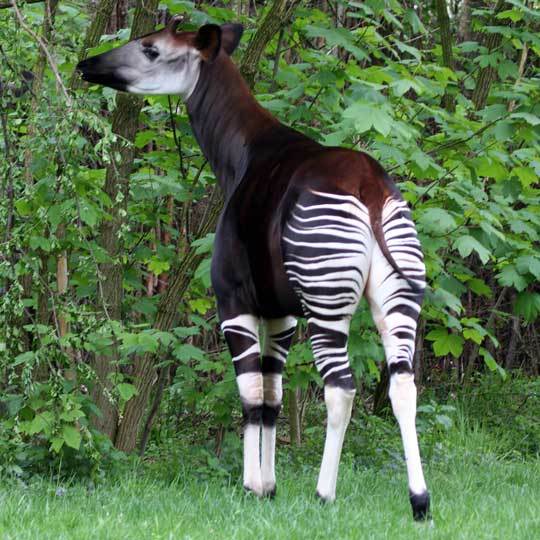
Okapis typically give birth to only one calf per breeding season. The calves are vulnerable to predation, so it helps that they can get up on their feet and start walking around within 30 minutes after being born. Here's an even more fascinating way the young avoid predators: okapi calves cannot poop until they are a month old. Why? This eliminates the possibility of the smell of young okapi feces attracting predators. At this moment, I'm trying not to visualize an okapi calf pooping after holding it in for a month.
Mother okapis communicate with their calves by making infrasonic sounds, which humans and some other animals can't hear. What is an infrasonic sound, you ask? Well, you've heard of ultrasonic sounds. Those are high-frequency sounds (frequencies above 20kHz). Infrasonic sounds have frequencies below 20Hz. So, ultrasonic is too high for humans to hear, infrasonic is too low for us to hear.
Guess what... leopards cannot hear infrasonic sounds either. Cool, huh?
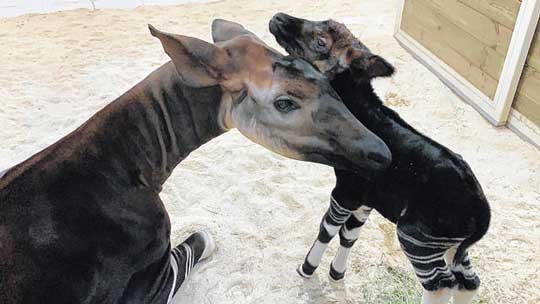
So, the Okapi deserves a place in the K.A.H.O.F.
(Knockout Animal Hall of Fame).
FUN FACT: The word knockout, originated in 1887, and it was used in reference to boxing, meaning "to stun by a blow for a 10-count." In 1892, people decided to expand the use of the word to also describe an "excellent thing or person." It wasn't until 1953 that it became a common way to describe a beautiful woman. Interestingly, starting in 1936, knock yourself out became a way to tell someone to "make a great effort."
Anyway, because knockout is used to describe someone or something as "excellent," it is another way to say awesome!
Photo Credits:
Black and rufous elephant shrew - DepositPhotos
Dog noses - DepositPhotos
Freddy Mercury and cat - AllThatsInteresting
Crow on the street with walnut - CrowBehavior
Okapi on white background - DepositPhotos
Okapi head closeup - DepositPhotos
Giraffe head closeup - DepositPhotos
Okapi tongue - kaelin, CC BY-SA 2.0 via Wikimedia Commons
Okapi from behind, with forest as background - DepositPhotos
Okapi with calf - Columbus Zoo

What the heck is an Okapi?
The okapi (pronounced oh-COP-ee) is not closely related to zebras. If you look at an okapi's head, you'll see that the general structure is similar to the head of a giraffe. In fact, okapis are the only living close relative of giraffes (in the family Giraffidae). In addition to the name zebra giraffe, it is also called the forest giraffe.
The okapi is an artiodactyl mammal (an ungulate that stands on two of its toes). They weigh from 440 to 770 pounds (200 to 350 kg) and stand about 5 feet (1.5 m) tall at the shoulder. Unfortunately, they are endangered, and their numbers have been reduced by half in the last 15 years.
Below you can see the resemblance between an okapi's head and a giraffe's head.

Amazing Facts about the Okapi
Did you notice the okapi in the first photo above does not have horns, but the one in the second photo does? That's because the first one is a female and the second is a male. Giraffes have these also. These short little horns are actually called ossicones. The weird thing is, only male okapis have ossicones, but both female and male giraffes have ossicones! Hmmm. What's up with that?
Have you ever watched a giraffe walk? Okapis and giraffes have a strange gait called a pacing gait—they step with both of the legs on one side of the body at the same time. So, they step forward with both the right legs, then step with both the left legs. All other ungulates walk by stepping forward with alternate legs on either side of the body. I know... it's hard to picture, isn't it? Check out this video of a giraffe's pacing gait.
Like giraffes, okapis have ridiculously long tongues. An okapi's tongue is 18 inches (46 cm) long! These creatures feed on understory plants in the forest, and this long tongue helps them select and pull off their favorite types of leaves. Also, the tongue is so long that they can use it to clean their eyes and even their ears. Below is an okapi grooming itself with its tongue.

The okapi keeps this long tongue busy by eating all day. In fact, they eat up to 60 pounds (27 kg) of plant material every day. They must not be too picky, because they have been observed eating over 100 different types of plants, some of which are poisonous to humans and other animals. They eat clay from the riverbeds to replenish salt and minerals. They also eat charred wood from trees that have been struck by lightning (again, probably to get minerals). And, as if that weren't strange enough, okapis even snarf up bat excrement. Yummy.
Check out this video about Okapis
Okapis live most of their lives alone, although occasionally they will gather in groups to eat, to groom each other, and to play.
What about those weird, zebra-like stripes on their legs and rump? These may help camouflage the okapi in its forest habitat (leopards are a natural predator of okapis). My favorite explanation, though, is that these are the okapi's "follow-me stripes." Some people believe the stripes help baby okapis see and follow the adults through the dense forest. Hmm... these seem to me to be contradictory explanations—one says the stripes hide the okapi, one says the stripes make the okapi more visible. Which do you think it is?

Okapis typically give birth to only one calf per breeding season. The calves are vulnerable to predation, so it helps that they can get up on their feet and start walking around within 30 minutes after being born. Here's an even more fascinating way the young avoid predators: okapi calves cannot poop until they are a month old. Why? This eliminates the possibility of the smell of young okapi feces attracting predators. At this moment, I'm trying not to visualize an okapi calf pooping after holding it in for a month.
Mother okapis communicate with their calves by making infrasonic sounds, which humans and some other animals can't hear. What is an infrasonic sound, you ask? Well, you've heard of ultrasonic sounds. Those are high-frequency sounds (frequencies above 20kHz). Infrasonic sounds have frequencies below 20Hz. So, ultrasonic is too high for humans to hear, infrasonic is too low for us to hear.
Guess what... leopards cannot hear infrasonic sounds either. Cool, huh?

So, the Okapi deserves a place in the K.A.H.O.F.
(Knockout Animal Hall of Fame).
FUN FACT: The word knockout, originated in 1887, and it was used in reference to boxing, meaning "to stun by a blow for a 10-count." In 1892, people decided to expand the use of the word to also describe an "excellent thing or person." It wasn't until 1953 that it became a common way to describe a beautiful woman. Interestingly, starting in 1936, knock yourself out became a way to tell someone to "make a great effort."
Anyway, because knockout is used to describe someone or something as "excellent," it is another way to say awesome!
Photo Credits:
Black and rufous elephant shrew - DepositPhotos
Dog noses - DepositPhotos
Freddy Mercury and cat - AllThatsInteresting
Crow on the street with walnut - CrowBehavior
Okapi on white background - DepositPhotos
Okapi head closeup - DepositPhotos
Giraffe head closeup - DepositPhotos
Okapi tongue - kaelin, CC BY-SA 2.0 via Wikimedia Commons
Okapi from behind, with forest as background - DepositPhotos
Okapi with calf - Columbus Zoo
Published on June 21, 2021 12:20
June 2, 2021
Awesome Animal - Paddlefish
Missouri has several big rivers flowing through it, including the Mississippi River and the Missouri River, as well as several large reservoirs. Big rivers (and therefore big reservoirs connected to those rivers) are home to some fairly large species of fish that grow to over 100 pounds (45 kg). In my opinion, one of the strangest of these fish is the paddlefish.
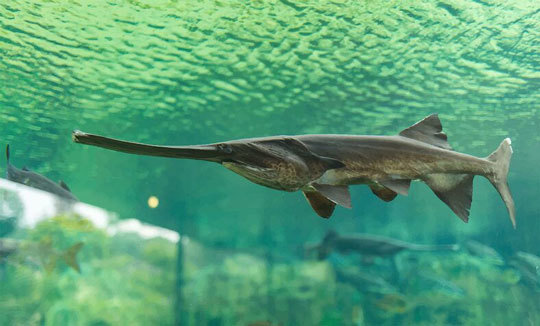
What the heck is a Paddlefish?
Paddlefish are unusual in that they are Chondrostean fish. This means they are mostly cartilaginous (cartilage skeleton instead of bone), but still they have a small amount of bony tissue. You may know that the true cartilaginous fish include sharks, rays, and skates, whereas bony fish include most of the other fish we are familiar with. The paddlefish lies somewhere between. Paddlefish have smooth skin, without scales.
Paddlefish are considered primitive fish, which means they have not changed significantly for a long time. In fact, they have not changed much at all from the earliest known paddlefish fossils, which are 120 to 125 million years old.
Only one living species remains, the American paddlefish, and it lives in the Mississippi River basin of North America. There was another species until recently, the Chinese paddlefish, but unfortunately that species was declared extinct in 2019. The two images below show what the Chinese paddlefish looked like.


Amazing Facts about the Paddlefish
Perhaps the paddlefish's most impressive feature is that long, spatula-like bill, which is called a rostrum. In fact, another name for paddlefish is spoonbill. So, what the heck is that bill for?
First, it's important to understand that paddlefish are plankton eaters. They feed almost entirely on zooplankton (tiny animals suspended in the water). For many years, scientists suggested that the paddlefish used its long bill to swish back and forth in the mud at the river's bottom to stir up a bunch of plankton. It was also suggested that it was somehow used to navigate through the muddy water. However, research with electron microscopes in the 1990s revealed that the rostrum is covered with tens of thousands of tiny electroreceptors. These receptors are so sensitive that they can detect the smallest movement of zooplankton in the water. They can even detect the movement of a single leg of some of the smallest (almost-microscopic) swimming arthropods (such as a water flea).
Amazingly, these electroreceptors are so sensitive that they can detect signals of less than 1/100th of one 1-millionth volt per centimeter. This is literally a superpower.
So, that paddle-like bill tells the paddlefish when it is swimming through a cloud of zooplanton. The paddlefish will then open its mouth as it swims forward, and thousands of tiny animals get filtered from the water by thin filters on the gills called gill rakers.
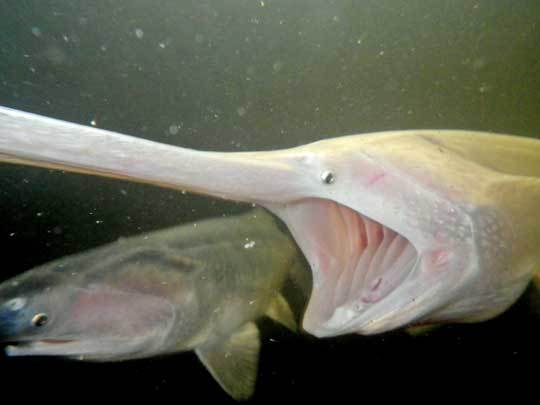
One more interesting tidbit about this impressive rostrum. When metal objects are placed in a paddlefish's swim path, they easily avoid them, even in the dark. However, when plastic objects are placed in their path, they collide with them. Hmm... so, the rostrum helps paddlefish navigate some of the time but not all the time. It seems to me the research would be more meaningful by studying the fish's ability to avoid natural objects like rocks, but I couldn't find that data anywhere.
Check out this video about paddlefish.
Fun fact: In 1997 Missouri designated the paddlefish as the state’s official aquatic animal.
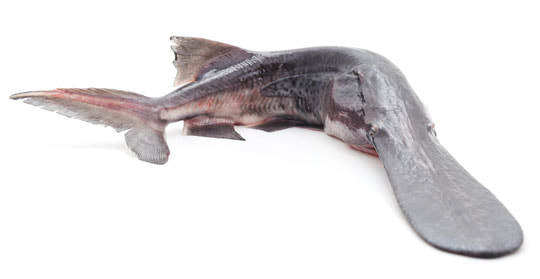
The paddlefish has a third eye on top of its head. This third eye does not see images, but it detects changes in light level, which helps the fish know when it is day and night.
Many states in the US, including Missouri, have initiated paddlefish breeding and stocking programs. Tens of thousands of young paddlefish are released in rivers and reservoirs each year. Part of the reason for this is that many of the rivers in the Mississippi River basin have been dammed in efforts to control severe flooding, to generate electricity, and to provide recreational reservoirs. These dams prevent paddlefish from spawning on most of these rivers, and therefore the only new paddlefish in these rivers are the fingerlings that are stocked annually.
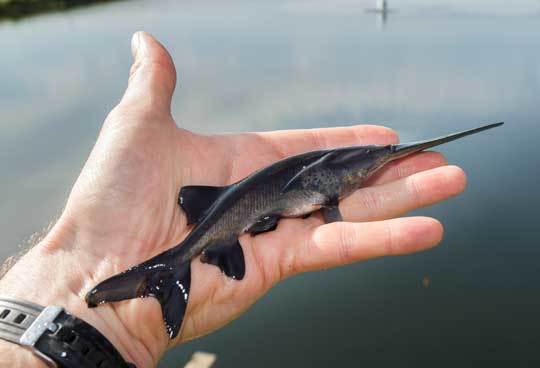
Young paddlefish are not strong swimmers, therefore they grow fast their first year, which reduces the chance of being eaten by predators. By the end of their first year, young paddlefish are about 12 inches (30 cm) long. After that, their growth slows down. By the time they are 5 years old, they grow only about 2 inches (5 cm) per year. They can live up to 30 years, eventually weighing over 100 pounds (45 kg).
To give you an idea of their size, below is a photo of the world record paddlefish caught in Oklahoma (it was released after weighing). The fish weighed 146.7 pounds (66.5 kg). NOTE: Fishing for paddlefish is strictly regulated, with limits and a brief season, in order to avoid overfishing. Most of the fish caught are those that were stocked by state wildlife agencies during the past decades. Fishing is only allowed in those waters where paddlefish are abundant.

So, the Paddlefish deserves a place in the P.A.H.O.F.
(Prizewinning Animal Hall of Fame).
FUN FACT: The word prize, with the meaning of "that which is obtained or offered as the reward of exertion or contest," originated in the 1300s. The Middle English word at that time was prise. The spelling with a "z" (prize) originated in the 1500s. The noun prizewinner didn't appear until about 1890, with the meaning "a person or thing that wins a prize or is deserving of a prize." Eventually, the adjective prizewinning became a common word to describe anything that is spectacular. Example: Stan writes prizewinning novels.
So, prizewinning is another way to say awesome!
Photo Credits:
Paddlefish #1, on green water background - Caviar Star
Paddlefish on white background - DepositPhotos
Chinese paddlefish photo - Wei Qiwei, CC BY-SA 3.0 via Wikimedia Commons
Chinese paddlefish illustration - Wikimedia Commons
Paddlefish feeding with mouth open - Garrison Dam National Fish Hatchery. Fish and Wildlife Service. U.S. Department of the Interior., Public domain, via Wikimedia Commons
Fingerling paddlefish at hatchery - USFWS Mountain-Prairie, Public domain, via Wikimedia Commons
World record paddlefish - Jason Schooley/ODWC via Wate.com

What the heck is a Paddlefish?
Paddlefish are unusual in that they are Chondrostean fish. This means they are mostly cartilaginous (cartilage skeleton instead of bone), but still they have a small amount of bony tissue. You may know that the true cartilaginous fish include sharks, rays, and skates, whereas bony fish include most of the other fish we are familiar with. The paddlefish lies somewhere between. Paddlefish have smooth skin, without scales.
Paddlefish are considered primitive fish, which means they have not changed significantly for a long time. In fact, they have not changed much at all from the earliest known paddlefish fossils, which are 120 to 125 million years old.
Only one living species remains, the American paddlefish, and it lives in the Mississippi River basin of North America. There was another species until recently, the Chinese paddlefish, but unfortunately that species was declared extinct in 2019. The two images below show what the Chinese paddlefish looked like.


Amazing Facts about the Paddlefish
Perhaps the paddlefish's most impressive feature is that long, spatula-like bill, which is called a rostrum. In fact, another name for paddlefish is spoonbill. So, what the heck is that bill for?
First, it's important to understand that paddlefish are plankton eaters. They feed almost entirely on zooplankton (tiny animals suspended in the water). For many years, scientists suggested that the paddlefish used its long bill to swish back and forth in the mud at the river's bottom to stir up a bunch of plankton. It was also suggested that it was somehow used to navigate through the muddy water. However, research with electron microscopes in the 1990s revealed that the rostrum is covered with tens of thousands of tiny electroreceptors. These receptors are so sensitive that they can detect the smallest movement of zooplankton in the water. They can even detect the movement of a single leg of some of the smallest (almost-microscopic) swimming arthropods (such as a water flea).
Amazingly, these electroreceptors are so sensitive that they can detect signals of less than 1/100th of one 1-millionth volt per centimeter. This is literally a superpower.
So, that paddle-like bill tells the paddlefish when it is swimming through a cloud of zooplanton. The paddlefish will then open its mouth as it swims forward, and thousands of tiny animals get filtered from the water by thin filters on the gills called gill rakers.

One more interesting tidbit about this impressive rostrum. When metal objects are placed in a paddlefish's swim path, they easily avoid them, even in the dark. However, when plastic objects are placed in their path, they collide with them. Hmm... so, the rostrum helps paddlefish navigate some of the time but not all the time. It seems to me the research would be more meaningful by studying the fish's ability to avoid natural objects like rocks, but I couldn't find that data anywhere.
Check out this video about paddlefish.
Fun fact: In 1997 Missouri designated the paddlefish as the state’s official aquatic animal.

The paddlefish has a third eye on top of its head. This third eye does not see images, but it detects changes in light level, which helps the fish know when it is day and night.
Many states in the US, including Missouri, have initiated paddlefish breeding and stocking programs. Tens of thousands of young paddlefish are released in rivers and reservoirs each year. Part of the reason for this is that many of the rivers in the Mississippi River basin have been dammed in efforts to control severe flooding, to generate electricity, and to provide recreational reservoirs. These dams prevent paddlefish from spawning on most of these rivers, and therefore the only new paddlefish in these rivers are the fingerlings that are stocked annually.

Young paddlefish are not strong swimmers, therefore they grow fast their first year, which reduces the chance of being eaten by predators. By the end of their first year, young paddlefish are about 12 inches (30 cm) long. After that, their growth slows down. By the time they are 5 years old, they grow only about 2 inches (5 cm) per year. They can live up to 30 years, eventually weighing over 100 pounds (45 kg).
To give you an idea of their size, below is a photo of the world record paddlefish caught in Oklahoma (it was released after weighing). The fish weighed 146.7 pounds (66.5 kg). NOTE: Fishing for paddlefish is strictly regulated, with limits and a brief season, in order to avoid overfishing. Most of the fish caught are those that were stocked by state wildlife agencies during the past decades. Fishing is only allowed in those waters where paddlefish are abundant.

So, the Paddlefish deserves a place in the P.A.H.O.F.
(Prizewinning Animal Hall of Fame).
FUN FACT: The word prize, with the meaning of "that which is obtained or offered as the reward of exertion or contest," originated in the 1300s. The Middle English word at that time was prise. The spelling with a "z" (prize) originated in the 1500s. The noun prizewinner didn't appear until about 1890, with the meaning "a person or thing that wins a prize or is deserving of a prize." Eventually, the adjective prizewinning became a common word to describe anything that is spectacular. Example: Stan writes prizewinning novels.
So, prizewinning is another way to say awesome!
Photo Credits:
Paddlefish #1, on green water background - Caviar Star
Paddlefish on white background - DepositPhotos
Chinese paddlefish photo - Wei Qiwei, CC BY-SA 3.0 via Wikimedia Commons
Chinese paddlefish illustration - Wikimedia Commons
Paddlefish feeding with mouth open - Garrison Dam National Fish Hatchery. Fish and Wildlife Service. U.S. Department of the Interior., Public domain, via Wikimedia Commons
Fingerling paddlefish at hatchery - USFWS Mountain-Prairie, Public domain, via Wikimedia Commons
World record paddlefish - Jason Schooley/ODWC via Wate.com
Published on June 02, 2021 08:36
May 21, 2021
Awesome Animal - Gerenuk
I recently saw a photo of a gerenuk, and I thought, What the hootenanny is that thing?! It looks like an antelope or gazelle, but with a really small head, long neck, long legs, and the ability to stand upright like a human.
I love discovering fascinating creatures I previously knew nothing about, so I did a bit of research. Behold, the magnificent gerenuk:

What the heck is a Gerenuk?
First of all, the name gerenuk means “giraffe-necked” in Somali. In fact, this creature is often called the giraffe gazelle (a gazelle is a slender type of antelope).
Gerenuk antelopes are relatively small, about 3 feet (0.91 m) tall while standing on all four feet, and weighing between 62 to 115 pounds (28 to 52 kg). They live in the arid areas near the Horn of Africa (on the east side of Africa). The gerenuk is one of the most desert-adapted antelopes, surviving for long periods of time without water.
Amazing Facts about Gerenuk
Perhaps the most striking thing about these gerenuk antelopes is that they are built for reaching high to eat the softer leaves that are far above the ground. The neck is extremely long, topped by an almost comically-small head.
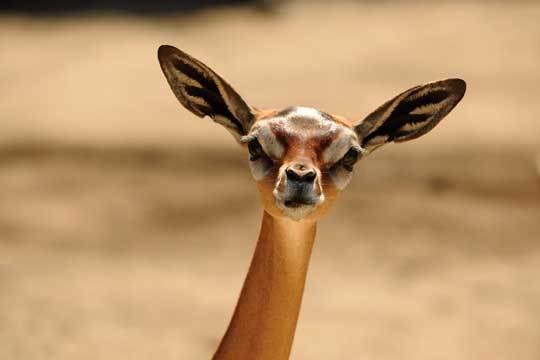
Why such a small head? With this animal, it's all about reaching high and nibbling on soft, yummy leaves. None of that grazing on the ground business! If you want to hold something up high, it's easier if the object is smaller and lighter, right? Hence the long, thin neck and the tiny head. And the gerenuk's snout is tapered into a small, pointed mouth—ideal for nibbling on tiny leaves that are located between nasty thorns. This antelope exemplifies elegance and grace, don't you think?
Standing straight up like that requires strong hind legs, and you can certainly see the legs' strength in the first photo above. In addition, the gerenuk has wedge-shaped hooves and specially-adapted vertebrae to help it stand erect. They are able to reach tender leaves, flowers, and fruits that many other animals can't. Because these choice foods contain a reasonable amount moisture, gerenuks rarely or never have to drink water.
Check out this video about gerenuks.
Gerenuks are what we call sexually dimorphic. That means the males and females look significantly different and are easy to distinguish. The males have horns and thicker necks, whereas the females never have horns, and their necks are amazingly slender. Here's a male gerenuk:

Gerenuks are not as social as most other antelopes. They are often observed living alone, or in herds of only two to six individuals.
Gerenuks can mate throughout the year, and when a male is in the mood, he becomes much less antisocial. He will seek out a suitable female, then stand in a sideways pose, showing off his horns. If the female indicates she is amply impressed, the male will "mark" her as his by rubbing a secretion from glands near his eyes onto her thighs. Once he has marked her, he will guard her from other males, following her around until she is ready to mate.
How does the male know the female is ready to mate? By sampling her urine. This is known as the lip curl test. When the female is ready to mate, the chemistry of her urine will change, and it will pass the male's lip curl test.
After a gestation period of six to seven months, females typically give birth to a single young. The mothers clean up their babies immediately, consuming the afterbirth to eliminate traces that might attract predators. Baby gerenuks are up and walking around only minutes after birth.

So, the Gerenuk deserves a place in the B.A.H.O.F.
(Bragworthy Animal Hall of Fame).
FUN FACT: The word brag can actually be used as a noun, a verb, or an adjective. The noun form means "a pompous or boastful statement." The verb means "to talk boastfully." The adjective means "first-rate" (as in, "Stan's novels are not only brag, they are the braggest"). The verb form of brag originated in the late 1300s and meant "to make a loud sound" or "to talk boastfully." It's unclear when the adjective bragworthy originated, but there is no doubt that it means "worth bragging about."
So, bragworthy is another way to say awesome!
Photo Credits:
Gerenuk #1 - standing on hind legs - DepositPhotos
Gerenuk #2 - head and neck - DepositPhotos
Gerenuk #3 - male standing on hind legs - DepositPhotos
Gerenuk female with young - ZooGirlSD via ZooChat
I love discovering fascinating creatures I previously knew nothing about, so I did a bit of research. Behold, the magnificent gerenuk:

What the heck is a Gerenuk?
First of all, the name gerenuk means “giraffe-necked” in Somali. In fact, this creature is often called the giraffe gazelle (a gazelle is a slender type of antelope).
Gerenuk antelopes are relatively small, about 3 feet (0.91 m) tall while standing on all four feet, and weighing between 62 to 115 pounds (28 to 52 kg). They live in the arid areas near the Horn of Africa (on the east side of Africa). The gerenuk is one of the most desert-adapted antelopes, surviving for long periods of time without water.
Amazing Facts about Gerenuk
Perhaps the most striking thing about these gerenuk antelopes is that they are built for reaching high to eat the softer leaves that are far above the ground. The neck is extremely long, topped by an almost comically-small head.

Why such a small head? With this animal, it's all about reaching high and nibbling on soft, yummy leaves. None of that grazing on the ground business! If you want to hold something up high, it's easier if the object is smaller and lighter, right? Hence the long, thin neck and the tiny head. And the gerenuk's snout is tapered into a small, pointed mouth—ideal for nibbling on tiny leaves that are located between nasty thorns. This antelope exemplifies elegance and grace, don't you think?
Standing straight up like that requires strong hind legs, and you can certainly see the legs' strength in the first photo above. In addition, the gerenuk has wedge-shaped hooves and specially-adapted vertebrae to help it stand erect. They are able to reach tender leaves, flowers, and fruits that many other animals can't. Because these choice foods contain a reasonable amount moisture, gerenuks rarely or never have to drink water.
Check out this video about gerenuks.
Gerenuks are what we call sexually dimorphic. That means the males and females look significantly different and are easy to distinguish. The males have horns and thicker necks, whereas the females never have horns, and their necks are amazingly slender. Here's a male gerenuk:

Gerenuks are not as social as most other antelopes. They are often observed living alone, or in herds of only two to six individuals.
Gerenuks can mate throughout the year, and when a male is in the mood, he becomes much less antisocial. He will seek out a suitable female, then stand in a sideways pose, showing off his horns. If the female indicates she is amply impressed, the male will "mark" her as his by rubbing a secretion from glands near his eyes onto her thighs. Once he has marked her, he will guard her from other males, following her around until she is ready to mate.
How does the male know the female is ready to mate? By sampling her urine. This is known as the lip curl test. When the female is ready to mate, the chemistry of her urine will change, and it will pass the male's lip curl test.
After a gestation period of six to seven months, females typically give birth to a single young. The mothers clean up their babies immediately, consuming the afterbirth to eliminate traces that might attract predators. Baby gerenuks are up and walking around only minutes after birth.

So, the Gerenuk deserves a place in the B.A.H.O.F.
(Bragworthy Animal Hall of Fame).
FUN FACT: The word brag can actually be used as a noun, a verb, or an adjective. The noun form means "a pompous or boastful statement." The verb means "to talk boastfully." The adjective means "first-rate" (as in, "Stan's novels are not only brag, they are the braggest"). The verb form of brag originated in the late 1300s and meant "to make a loud sound" or "to talk boastfully." It's unclear when the adjective bragworthy originated, but there is no doubt that it means "worth bragging about."
So, bragworthy is another way to say awesome!
Photo Credits:
Gerenuk #1 - standing on hind legs - DepositPhotos
Gerenuk #2 - head and neck - DepositPhotos
Gerenuk #3 - male standing on hind legs - DepositPhotos
Gerenuk female with young - ZooGirlSD via ZooChat
Published on May 21, 2021 07:08
May 7, 2021
Awesome Animal - Green Sea Slug
It's an animal... it's a plant... it's a plantimal!
There are some organisms that blur the lines between kingdoms, especially when you look at organisms in the protist, fungi, and bacteria kingdoms. Such blurred lines involving animals are less common, however, and people find them particularly fascinating.
(Thanks to Linda Torres, a former student of mine, for suggesting this awesome animal.)
I thought it would be fun to take a look at one awesome example, the green sea slug (Elysia chlorotica). This creature has been referred to as a "solar-powered crawling leaf."

What the heck is a Green Sea Slug?
First of all, I should point out that my opening sentence above is somewhat exaggerated. The green sea slug is obviously an animal, just as all sea slugs are animals. This creature does not tempt us to create a new kingdom called plantimals (although that would be cool!).
Green sea slugs, like all slugs, are mollusks (in the phylum Mollusca, along with snails, clams, octopuses, squid, and many others). To narrow it down, green sea slugs are in a group called the sap-sucking sea slugs. They're called sap-sucking because they suck up the cellular contents of photosynthetic algae then use these cellular contents for themselves. Some of them simply digest the cellular contents for food, but others (like the green sea slug) save the living chloroplasts from the algae to use in their own bodies for photosynthesis. This is a rare process known as kleptoplasty (klepto means thief, plasty refers to the stolen chloroplasts).
By the way, chloroplasts are the organelles within a plant or algae cell that conduct photosynthesis.
Green sea slugs live along the east coast of North America, particularly in shallow salt marshes and tidal pools, where there is plenty of available sunlight.
Amazing Facts about Green Sea Slugs
If you haven't already guessed, these sea slugs are bright green due to the presence of the stolen chloroplasts, which become distributed throughout the slug's body. Unlike snails, slugs do not have protective shells, so the green color also helps to camouflage these slugs, hiding them from predators.

I need to point out an important distinction. A number of different animals (such as corals) keep live algae inside their bodies so that they can benefit from the algae's ongoing photosynthesis. This could be considered a mutualistic relationship between the animal (coral) and the algae, because they both benefit from the convenient arrangement. The green sea slug, on the other hand, breaks down the cells of the algae, and it extracts the algae's chloroplasts and actually uses them within its own cells. Big difference, right? This is not mutualism at all, because the algae obviously does not benefit from being destroyed and eaten.
Researchers have found that once a young green sea slug eats its fill of algae for the first time in its life, it never has to eat again, as long as it has access to sunlight. From that point on, the ingested chloroplasts provide it with the food it needs.
Just for fun, let's extrapolate this lifestyle to consider what it might be like if humans could do this. In this scenario, after you're born you feed on your mother's breast milk until you're old enough to gobble up a bowl full of live algae. Soon after, your skin turns green. From then on, you never have to eat again, although you would have to stay out in the sunlight a good portion of each day, during which you would have to strip down to your birthday suit because clothing would block the sun and prevent photosynthesis.
Okay, that's just downright silly. But wouldn't it be awesome?

Wait, there's more to the green sea slug's strange photosynthetic ability. In 2007 scientists discovered that there are genes in green sea slugs that are associated with photosynthesis. These genes are supposedly from the algae eaten by the slugs, but the genes even show up in young slugs that have never eaten algae. Subsequent research revealed even more algae genes in the slugs, some of which are known to play a role in manufacturing chlorophyll. To make a long story short, the research is starting to show that green sea slugs might be capable not only of using the chloroplasts from the algae they eat, they may also be capable of manufacturing their OWN chlorophyll (using the genes they stole from the algae).
If so, this makes green sea slugs the only animal known to be capable of making chlorophyll!
Here is a video that explain this a bit more.
And here's a video showing a green sea slug's movements.
Here's a green sea slug with its leaf-like sides rolled up (they do not need to be extended when there is little or no sunlight available).
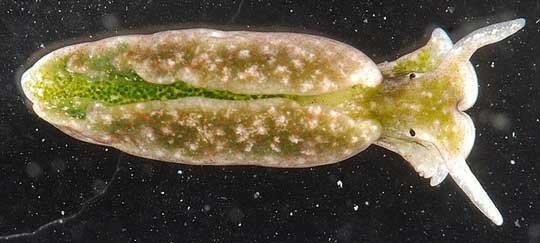
So far I've been writing this as if Elysia chlorotica is the only species of sea slug with these photosynthetic abilities. However, the sap-sucking sea slug group includes several similar species. For example, the species Elysia timida is also known to eat algae and put the ingested chloroplasts to work photosynthesizing in its own body:

So, the Green Sea Slug deserves a place in the A.A.H.O.F.
(Astonishing Animal Hall of Fame).
FUN FACT: The word astonishing, an adjective meaning "causing a feeling of great surprise or wonder," originated in about 1620. As I'm sure you can guess, it is derived from the word astonish, which originated in about 1520 and which literally meant, "to leave someone thunderstruck." Later, the related word astonishment originated in about 1570, with the meaning "paralysis." So, you can see that the early words related to astonishing focused on the dramatic, overwhelming, and possibly even detrimental effects on someone after witnessing or learning something shocking. Later on, astonishing came to be used in a more general sense to describe anything that was unusually remarkable.
So, astonishing is another way to say awesome!
Photo Credits:
Two green sea slugs on white background - PlantPhysiol.org
Green sea slug feeding on algae, with brown background - Karen N. Pelletreau et al., CC BY 4.0 via Wikimedia Commons
Green sea slug with sides curled up - Smithsonian Environmental Research Center, CC BY 2.0, via Wikimedia Commons
Elysia timidia - Elysia_timida_(Risso,_1818)_.jpg: Parent Géryderivative work: Channer, Public domain, via Wikimedia Commons
There are some organisms that blur the lines between kingdoms, especially when you look at organisms in the protist, fungi, and bacteria kingdoms. Such blurred lines involving animals are less common, however, and people find them particularly fascinating.
(Thanks to Linda Torres, a former student of mine, for suggesting this awesome animal.)
I thought it would be fun to take a look at one awesome example, the green sea slug (Elysia chlorotica). This creature has been referred to as a "solar-powered crawling leaf."

What the heck is a Green Sea Slug?
First of all, I should point out that my opening sentence above is somewhat exaggerated. The green sea slug is obviously an animal, just as all sea slugs are animals. This creature does not tempt us to create a new kingdom called plantimals (although that would be cool!).
Green sea slugs, like all slugs, are mollusks (in the phylum Mollusca, along with snails, clams, octopuses, squid, and many others). To narrow it down, green sea slugs are in a group called the sap-sucking sea slugs. They're called sap-sucking because they suck up the cellular contents of photosynthetic algae then use these cellular contents for themselves. Some of them simply digest the cellular contents for food, but others (like the green sea slug) save the living chloroplasts from the algae to use in their own bodies for photosynthesis. This is a rare process known as kleptoplasty (klepto means thief, plasty refers to the stolen chloroplasts).
By the way, chloroplasts are the organelles within a plant or algae cell that conduct photosynthesis.
Green sea slugs live along the east coast of North America, particularly in shallow salt marshes and tidal pools, where there is plenty of available sunlight.
Amazing Facts about Green Sea Slugs
If you haven't already guessed, these sea slugs are bright green due to the presence of the stolen chloroplasts, which become distributed throughout the slug's body. Unlike snails, slugs do not have protective shells, so the green color also helps to camouflage these slugs, hiding them from predators.

I need to point out an important distinction. A number of different animals (such as corals) keep live algae inside their bodies so that they can benefit from the algae's ongoing photosynthesis. This could be considered a mutualistic relationship between the animal (coral) and the algae, because they both benefit from the convenient arrangement. The green sea slug, on the other hand, breaks down the cells of the algae, and it extracts the algae's chloroplasts and actually uses them within its own cells. Big difference, right? This is not mutualism at all, because the algae obviously does not benefit from being destroyed and eaten.
Researchers have found that once a young green sea slug eats its fill of algae for the first time in its life, it never has to eat again, as long as it has access to sunlight. From that point on, the ingested chloroplasts provide it with the food it needs.
Just for fun, let's extrapolate this lifestyle to consider what it might be like if humans could do this. In this scenario, after you're born you feed on your mother's breast milk until you're old enough to gobble up a bowl full of live algae. Soon after, your skin turns green. From then on, you never have to eat again, although you would have to stay out in the sunlight a good portion of each day, during which you would have to strip down to your birthday suit because clothing would block the sun and prevent photosynthesis.
Okay, that's just downright silly. But wouldn't it be awesome?

Wait, there's more to the green sea slug's strange photosynthetic ability. In 2007 scientists discovered that there are genes in green sea slugs that are associated with photosynthesis. These genes are supposedly from the algae eaten by the slugs, but the genes even show up in young slugs that have never eaten algae. Subsequent research revealed even more algae genes in the slugs, some of which are known to play a role in manufacturing chlorophyll. To make a long story short, the research is starting to show that green sea slugs might be capable not only of using the chloroplasts from the algae they eat, they may also be capable of manufacturing their OWN chlorophyll (using the genes they stole from the algae).
If so, this makes green sea slugs the only animal known to be capable of making chlorophyll!
Here is a video that explain this a bit more.
And here's a video showing a green sea slug's movements.
Here's a green sea slug with its leaf-like sides rolled up (they do not need to be extended when there is little or no sunlight available).

So far I've been writing this as if Elysia chlorotica is the only species of sea slug with these photosynthetic abilities. However, the sap-sucking sea slug group includes several similar species. For example, the species Elysia timida is also known to eat algae and put the ingested chloroplasts to work photosynthesizing in its own body:

So, the Green Sea Slug deserves a place in the A.A.H.O.F.
(Astonishing Animal Hall of Fame).
FUN FACT: The word astonishing, an adjective meaning "causing a feeling of great surprise or wonder," originated in about 1620. As I'm sure you can guess, it is derived from the word astonish, which originated in about 1520 and which literally meant, "to leave someone thunderstruck." Later, the related word astonishment originated in about 1570, with the meaning "paralysis." So, you can see that the early words related to astonishing focused on the dramatic, overwhelming, and possibly even detrimental effects on someone after witnessing or learning something shocking. Later on, astonishing came to be used in a more general sense to describe anything that was unusually remarkable.
So, astonishing is another way to say awesome!
Photo Credits:
Two green sea slugs on white background - PlantPhysiol.org
Green sea slug feeding on algae, with brown background - Karen N. Pelletreau et al., CC BY 4.0 via Wikimedia Commons
Green sea slug with sides curled up - Smithsonian Environmental Research Center, CC BY 2.0, via Wikimedia Commons
Elysia timidia - Elysia_timida_(Risso,_1818)_.jpg: Parent Géryderivative work: Channer, Public domain, via Wikimedia Commons
Published on May 07, 2021 07:41
April 18, 2021
Awesome Animal - Flying Squirrel
When I was a kid, I assumed flying squirrels actually looked like this:

Yep, that's Rocky of the Rocky and Bullwinkle cartoon. Then, when I was about twelve, a friend of mine somehow ordered a pair of live flying squirrels in the mail (back in those days you could order almost any kind of wild animal... fortunately we now have regulations to limit this). He kept them in a cage in his bedroom, and sometimes we would get them out and let them run and jump around in the room. I was fascinated by the way they could spread their arms and legs and glide through the air. By the way... they were not very suitable as pets!
What the heck is a Flying Squirrel?
Flying squirrels are actual squirrels, which means they are rodents. Although here in North America we only have three species of flying squirrels, there are about fifty species worldwide, particularly in China and Southeast Asia. As you probably know, flying squirrels cannot actually fly the way birds and bats fly. Instead, they can glide from tree to tree on the thin flaps of skin between their forelegs and hind legs. They can precisely control their gliding direction and speed by moving their legs and tail. Notice the loose folds of skin on the southern flying squirrel below (this is the type that lives in the forest around our home in Missouri):

It is worth pointing out that sugar gliders are not flying squirrels. I mention this because many of you may have seen sugar gliders for sale in pet stores. Sugar gliders are actually a type of possum, which means they are marsupials. So, they are not closely related to squirrels at all. However, sugar gliders can glide just like flying squirrels, so this is a fascinating example of convergent evolution (when living things that are not closely related develop similar characteristics because they have adapted to the same kinds of environments). Below is a sugar glider:
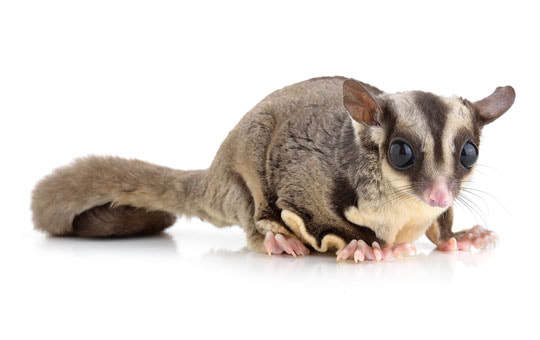 Amazing Facts about Flying Squirrels
Amazing Facts about Flying Squirrels
So, how exactly do these rodents glide? Flying squirrels have a thin flap of skin that stretches out along the sides of their body between their ankles and wrists. This flap is called the patagium. When they spread out their arms and legs, the patagium basically becomes a parachute.
Although flying squirrels are much like other squirrels in most ways, they have a few adaptations to enhance their gliding ability. For example, their leg and arm bones are longer, while their hand and foot bones are shorter. The longer limb bones allows them to create a larger parachute, while the shorter hand and foot bones allow them to better control the parachute. Check out the skeletal structure below.

Flying squirrels have a surprising amount of control over their gliding flight. In fact, they can even create lift by changing the angle of their limbs. Astoundingly, flying squirrels have been observed gliding up to 300 feet (90 meters)!
Notice the finger-like projection sticking out from each of the hands? This is an unusual piece of cartilage that the squirrel can hold vertically, thus providing stability and controlling the direction of flight. No other squirrels have this cartilage projection—only the flying squirrels.
Numerous hypotheses have been suggested to explain the evolution of gliding in flying squirrels. In my opinion, the most reasonable hypothesis is that this adaptation arose because it allows these squirrels to move from tree to tree without expending much energy. Gliding from one tree to another uses much less energy than descending to the ground and then climbing up another tree (not to mention that being on the ground makes the squirrel more vulnerable to predators). So... why don't all squirrels have this ability? That's a good question.
Check out this cool video about how they fly.

Most flying squirrel species are nocturnal, and they are extremely shy, so humans do not often have a chance to see them. Amazingly, Trish and I have only seen one southern flying squirrel in the wild, although they are abundant in our area. Spotting this creature took some effort. We had been hearing the creatures running around on our roof during the night, so we decided to sit out on the deck one night to see if we could spot one. We could hear these strange, high-pitched calls in a tree near us, so I switched on a spotlight. We saw the glow of the flying squirrel's eyes as it stared back at us. We have never seen one during daylight hours.
This is what it looked like: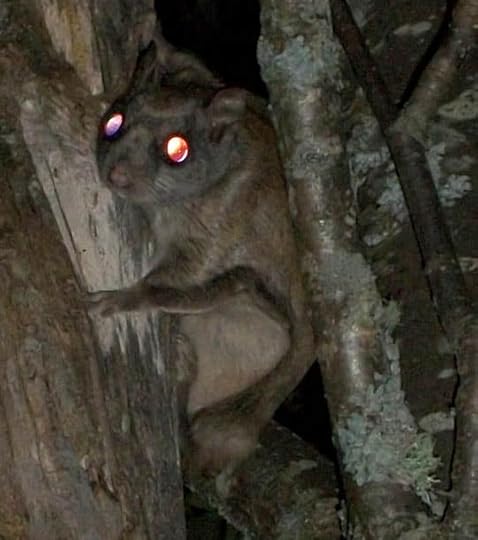
Amazingly, scientists have recently (and by accident) discovered that all three of the North American species of flying squirrels glow PINK under a UV light! No one really knows why, although scientists have hypothesized that it might be related to avoiding predators, or to communication between squirrels, or possibly to help them navigate while gliding. Here's a video about this flying squirrel superpower.
Flying squirrels are omnivores and eat a surprising variety of different foods. They have been known to eat fruits, seeds, flowers, buds, snails, insects, fungi, lichens, bird's eggs, spiders, and even tree sap.
Finally, flying squirrels come in a wide variety of sizes. The three species found in North America are all about the size of the palm of your hand, but the woolly flying squirrel, which lives in Pakistan, is the largest species, weighing 5.5 pounds (2.5 kg). The smallest species, the Hose's pygmy flying squirrel of Borneo, weighs only 2.5 ounces (70 grams).
Check out this red and white giant flying squirrel from China!
(photo by Will Burrard-Lucas)

So, the Flying Squirrel deserves a place in the H.A.H.O.F.
(High-class Animal Hall of Fame).
FUN FACT: The term high-class, an adjective meaning "of superior quality or status" can be traced back to about 1833. Originally, at that time, it probably meant "of high social rank," suggesting (in a rather snobbish way) that people in higher social classes were of higher quality. Alternatively, it may have been used by people of lower socioeconomic classes to (perhaps derisively) describe someone or something as "very fancy, wealthy, or expensive." Regardless, it has come to be used widely as a more general term (a high-class hotel, a high-class jeweler, a high-class author).
So, high-class is another way to say awesome!
Photo Credits:
Rocky the flying squirrel - Wikimedia Commons
Flying squirrel on a tree, photo #1 - DepositPhotos
Sugar glider - DepositPhotos
Flying squirrel skeleton - Bj.schoenmakers, CC BY-SA 4.0 via Wikimedia Commons
Flying squirrel gliding through room - Bluedustmite at English Wikipedia, CC BY-SA 3.0 via Wikimedia Commons
Flying squirrel with glowing eyes - PJTurgeon, CC BY-SA 3.0 via Wikimedia Commons
Red and White giant flying squirrel - Will Burrard-Lucas

Yep, that's Rocky of the Rocky and Bullwinkle cartoon. Then, when I was about twelve, a friend of mine somehow ordered a pair of live flying squirrels in the mail (back in those days you could order almost any kind of wild animal... fortunately we now have regulations to limit this). He kept them in a cage in his bedroom, and sometimes we would get them out and let them run and jump around in the room. I was fascinated by the way they could spread their arms and legs and glide through the air. By the way... they were not very suitable as pets!
What the heck is a Flying Squirrel?
Flying squirrels are actual squirrels, which means they are rodents. Although here in North America we only have three species of flying squirrels, there are about fifty species worldwide, particularly in China and Southeast Asia. As you probably know, flying squirrels cannot actually fly the way birds and bats fly. Instead, they can glide from tree to tree on the thin flaps of skin between their forelegs and hind legs. They can precisely control their gliding direction and speed by moving their legs and tail. Notice the loose folds of skin on the southern flying squirrel below (this is the type that lives in the forest around our home in Missouri):

It is worth pointing out that sugar gliders are not flying squirrels. I mention this because many of you may have seen sugar gliders for sale in pet stores. Sugar gliders are actually a type of possum, which means they are marsupials. So, they are not closely related to squirrels at all. However, sugar gliders can glide just like flying squirrels, so this is a fascinating example of convergent evolution (when living things that are not closely related develop similar characteristics because they have adapted to the same kinds of environments). Below is a sugar glider:
 Amazing Facts about Flying Squirrels
Amazing Facts about Flying SquirrelsSo, how exactly do these rodents glide? Flying squirrels have a thin flap of skin that stretches out along the sides of their body between their ankles and wrists. This flap is called the patagium. When they spread out their arms and legs, the patagium basically becomes a parachute.
Although flying squirrels are much like other squirrels in most ways, they have a few adaptations to enhance their gliding ability. For example, their leg and arm bones are longer, while their hand and foot bones are shorter. The longer limb bones allows them to create a larger parachute, while the shorter hand and foot bones allow them to better control the parachute. Check out the skeletal structure below.

Flying squirrels have a surprising amount of control over their gliding flight. In fact, they can even create lift by changing the angle of their limbs. Astoundingly, flying squirrels have been observed gliding up to 300 feet (90 meters)!
Notice the finger-like projection sticking out from each of the hands? This is an unusual piece of cartilage that the squirrel can hold vertically, thus providing stability and controlling the direction of flight. No other squirrels have this cartilage projection—only the flying squirrels.
Numerous hypotheses have been suggested to explain the evolution of gliding in flying squirrels. In my opinion, the most reasonable hypothesis is that this adaptation arose because it allows these squirrels to move from tree to tree without expending much energy. Gliding from one tree to another uses much less energy than descending to the ground and then climbing up another tree (not to mention that being on the ground makes the squirrel more vulnerable to predators). So... why don't all squirrels have this ability? That's a good question.
Check out this cool video about how they fly.

Most flying squirrel species are nocturnal, and they are extremely shy, so humans do not often have a chance to see them. Amazingly, Trish and I have only seen one southern flying squirrel in the wild, although they are abundant in our area. Spotting this creature took some effort. We had been hearing the creatures running around on our roof during the night, so we decided to sit out on the deck one night to see if we could spot one. We could hear these strange, high-pitched calls in a tree near us, so I switched on a spotlight. We saw the glow of the flying squirrel's eyes as it stared back at us. We have never seen one during daylight hours.
This is what it looked like:

Amazingly, scientists have recently (and by accident) discovered that all three of the North American species of flying squirrels glow PINK under a UV light! No one really knows why, although scientists have hypothesized that it might be related to avoiding predators, or to communication between squirrels, or possibly to help them navigate while gliding. Here's a video about this flying squirrel superpower.
Flying squirrels are omnivores and eat a surprising variety of different foods. They have been known to eat fruits, seeds, flowers, buds, snails, insects, fungi, lichens, bird's eggs, spiders, and even tree sap.
Finally, flying squirrels come in a wide variety of sizes. The three species found in North America are all about the size of the palm of your hand, but the woolly flying squirrel, which lives in Pakistan, is the largest species, weighing 5.5 pounds (2.5 kg). The smallest species, the Hose's pygmy flying squirrel of Borneo, weighs only 2.5 ounces (70 grams).
Check out this red and white giant flying squirrel from China!
(photo by Will Burrard-Lucas)

So, the Flying Squirrel deserves a place in the H.A.H.O.F.
(High-class Animal Hall of Fame).
FUN FACT: The term high-class, an adjective meaning "of superior quality or status" can be traced back to about 1833. Originally, at that time, it probably meant "of high social rank," suggesting (in a rather snobbish way) that people in higher social classes were of higher quality. Alternatively, it may have been used by people of lower socioeconomic classes to (perhaps derisively) describe someone or something as "very fancy, wealthy, or expensive." Regardless, it has come to be used widely as a more general term (a high-class hotel, a high-class jeweler, a high-class author).
So, high-class is another way to say awesome!
Photo Credits:
Rocky the flying squirrel - Wikimedia Commons
Flying squirrel on a tree, photo #1 - DepositPhotos
Sugar glider - DepositPhotos
Flying squirrel skeleton - Bj.schoenmakers, CC BY-SA 4.0 via Wikimedia Commons
Flying squirrel gliding through room - Bluedustmite at English Wikipedia, CC BY-SA 3.0 via Wikimedia Commons
Flying squirrel with glowing eyes - PJTurgeon, CC BY-SA 3.0 via Wikimedia Commons
Red and White giant flying squirrel - Will Burrard-Lucas
Published on April 18, 2021 16:23
April 7, 2021
Awesome Animal - Aye-aye
Just about everyone is familiar with lemurs, right? Think of the movie Madagascar. Lemurs, lemurs, lemurs. For some reason, though, at least for me, one species of lemur really stands out as bizarrely different from the others—the aye-aye. Let's check this critter out, shall we?
What the heck is an Aye-aye?
The aye-aye (pronounced eye-eye) is the world's largest nocturnal primate. Lemurs live only in Madagascar, and there are about 100 species, but the aye-aye is the only living lemur species in the genus Daubentonia. Unfortunately, the aye-aye is endangered. In fact, in 1933 it was thought to be extinct, Then it was rediscovered in 1957. The aye-aye is a rather strange-looking creature.
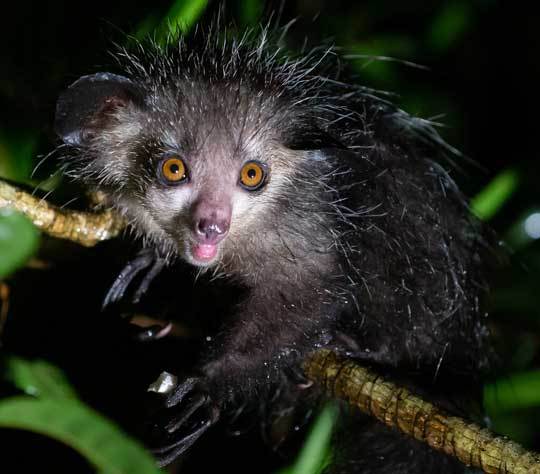
Amazing Facts about the Aye-aye
Besides its striking appearance, perhaps the aye-aye's most unusual characteristic is the way it finds and consumes its prey. These lemurs will eat a variety of foods including fruits, seeds, insects, and flower nectar. However, it also has an unusual superpower. The aye-aye is one of only two known animal species that feed with a specialized technique called percussive foraging. (the other animal is the striped possum).
It all starts with the creature's unusually long fingers, particularly the really thin middle finger.
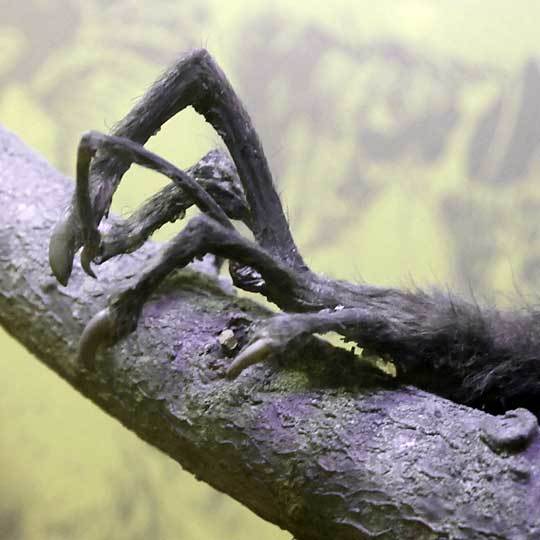
Although the aye-aye's middle finger seems perfectly suited for making a rude gesture, it actually serves a more practical purpose. The aye-aye uses the finger to tap on the surface of trees. As it taps, it pushes its large ears to the tree, listening for indications of hollow tunnels created by wood-boring grubs. This is actually a specialized form of echolocation.
When the aye-aye "hears" a hollow tunnel, it then chews through the bark and wood with its sharp teeth to access the tunnel. Then it inserts its long, thin middle finger into the tunnel, feeling around for the grub. When it finds the grub, it's hook-shaped claw skewers the insect, and the aye-aye pulls it out and chomps down on a nice, juicy meal.
What an amazing way to find food!
Check out this video showing how the aye-aye feeds using percussive foraging techniques.
Another unusual feature of the aye-aye is that it has front incisors that look very much like rodent incisors. In fact, like rodent incisors, these teeth grow continuously and must be constantly worn down by chewing. These teeth help the aye-aye gnaw through wood to get to those yummy grubs, and it also helps the aye-aye chew into coconuts. This type of teeth is unique among lemurs, and when the aye-aye was first discovered by scientists, they mistakenly classified it as a rodent, specifically a type of squirrel.
Check out the aye-aye skeleton below.
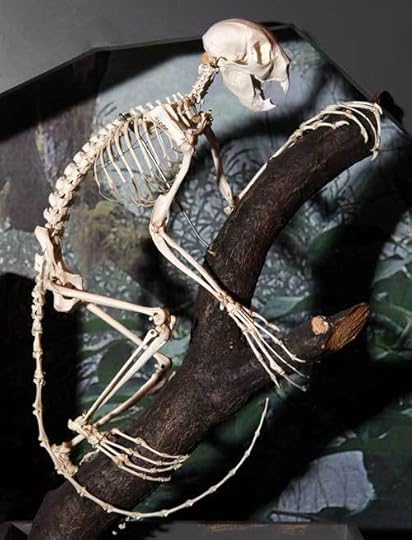
So, what exactly is an aye-aye? DNA studies have led scientists to conclude it is definitely a type of lemur, but it is considered the most primitive of all the lemurs. By the way, primitive does not mean stupid or un-evolved (every type of organism alive today has evolved for just as long as all other types of organisms... bacteria are just as evolved as humans... they are simply different from humans). In this case, I'm using primitive to describe the aye-aye as most similar to the original ancestors of all lemurs.
Scientists have long assumed all lemurs originated on Madagascar from some early primates that drifted on natural rafts across the water from Africa. However, the aye-aye's characteristics have led scientist to hypothesize that the ancestors of aye-ayes rafted to Madagascar at a different time, perhaps earlier than the ancestors of the other lemurs. This helps to explain why the aye-aye is so different from the other lemurs.
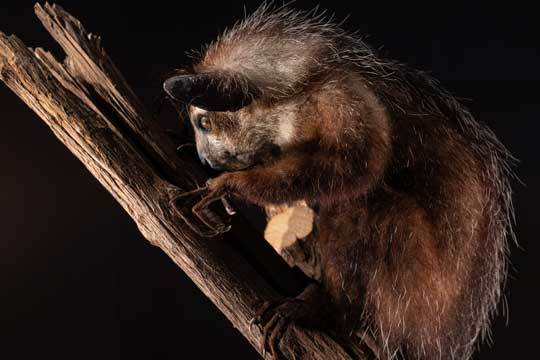
Aye-ayes spend almost all their lives in the trees, rarely venturing down to the ground. During the day they sleep in nests made of leaves, then they come out at night to forage and hunt for food.
Unlike the other lemurs, aye-ayes can reproduce at any time of the year. When a female is ready to mate, she calls out to attract males. The males, which usually get along with each just fine and even share their territories, then gather around the female and become really aggressive to one another, fighting for the right to breed with the female.
After a gestation period of about five months, females give birth to only one baby. The baby stays in the nest for two months and then stays with its mother for two years before wandering off to establish its own territory.
As you can imagine, baby aye-ayes look just as strange as the adults.
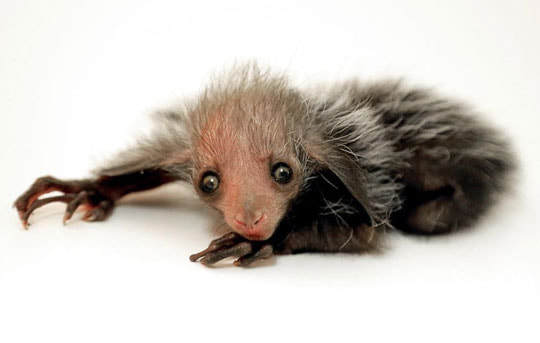 As I mentioned above, aye-ayes are an endangered species. This is an unfortunate consequence of three factors. First, the destruction of forest in Madagascar. Second, farmers often kill them to protect their crops, although there is little evidence that aye-ayes are destructive to cultivated crops.
As I mentioned above, aye-ayes are an endangered species. This is an unfortunate consequence of three factors. First, the destruction of forest in Madagascar. Second, farmers often kill them to protect their crops, although there is little evidence that aye-ayes are destructive to cultivated crops.
The third reason is based on unfortunate folk beliefs. In Madagascar, there are numerous folk legends about aye-ayes. Some people believe they are evil omens of death. If an aye-aye shows up in a village, that means it must be killed or someone in the village will die. Some people believe that if an aye-aye points its thin, middle finger at someone, that person will drop dead. Some even believe aye-ayes sneak into homes while the residents are sleeping and use that middle finger to puncture the sleeping person's aorta, thus killing them in their sleep. Needless to say, none of these beliefs are true, but they have resulted in a hatred of these animals, and aye-ayes are often killed on sight.
Fortunately, their numbers have increased somewhat since the 1980s, and several captive breeding programs are helping us learn more about aye-ayes so we can prevent their extinction.

So, the Aye-aye deserves a place in the B.A.H.O.F.
(Bang-up Animal Hall of Fame).
FUN FACT: The term bang-up is an adjective meaning "excellent or extraordinary." In order to trace its roots, we first need to look at the word bang. Bang appeared in the English language in the mid 1500s, and it was a simulation of the sound of something striking something else with great force (a word that sounds like the natural sound it describes is called an onomatopoeia). The word bang turned out to be a great all-around useful word over the centuries. Its meanings include “to beat or injure violently," a noun meaning “thrill” (I got a real bang out of Stan's latest novel), “to bang out,” which means to produce or write something rapidly. These are just a few of its many uses. Bang-up may have originated in England in the 1800s as a way to describe something as “fashionable or stylish.” From 1843: "His spotted neckcloth knotted in bang-up mode..." Eventually it came to be used for anything that is extraordinarily good, especially in this context: "Stan did a bang-up job on that novel."
Anyway, bang-up is another way to say awesome!
Photo Credits:
Aye-aye #1 - DepositPhotos
Aye-aye fingers - Dr. Mirko Junge, CC BY-SA 2.0 - Wikimedia Commons
Aye-aye skeleton - Dr. Mirko Junge, CC BY-SA 2.0 - Wikimedia Commons
Aye-aye poking finger into tree limb - DepositPhotos
Baby aye-aye - Denver Zoo
Aye-aye in front of cinder-block wall - Denver Zoo
What the heck is an Aye-aye?
The aye-aye (pronounced eye-eye) is the world's largest nocturnal primate. Lemurs live only in Madagascar, and there are about 100 species, but the aye-aye is the only living lemur species in the genus Daubentonia. Unfortunately, the aye-aye is endangered. In fact, in 1933 it was thought to be extinct, Then it was rediscovered in 1957. The aye-aye is a rather strange-looking creature.

Amazing Facts about the Aye-aye
Besides its striking appearance, perhaps the aye-aye's most unusual characteristic is the way it finds and consumes its prey. These lemurs will eat a variety of foods including fruits, seeds, insects, and flower nectar. However, it also has an unusual superpower. The aye-aye is one of only two known animal species that feed with a specialized technique called percussive foraging. (the other animal is the striped possum).
It all starts with the creature's unusually long fingers, particularly the really thin middle finger.

Although the aye-aye's middle finger seems perfectly suited for making a rude gesture, it actually serves a more practical purpose. The aye-aye uses the finger to tap on the surface of trees. As it taps, it pushes its large ears to the tree, listening for indications of hollow tunnels created by wood-boring grubs. This is actually a specialized form of echolocation.
When the aye-aye "hears" a hollow tunnel, it then chews through the bark and wood with its sharp teeth to access the tunnel. Then it inserts its long, thin middle finger into the tunnel, feeling around for the grub. When it finds the grub, it's hook-shaped claw skewers the insect, and the aye-aye pulls it out and chomps down on a nice, juicy meal.
What an amazing way to find food!
Check out this video showing how the aye-aye feeds using percussive foraging techniques.
Another unusual feature of the aye-aye is that it has front incisors that look very much like rodent incisors. In fact, like rodent incisors, these teeth grow continuously and must be constantly worn down by chewing. These teeth help the aye-aye gnaw through wood to get to those yummy grubs, and it also helps the aye-aye chew into coconuts. This type of teeth is unique among lemurs, and when the aye-aye was first discovered by scientists, they mistakenly classified it as a rodent, specifically a type of squirrel.
Check out the aye-aye skeleton below.

So, what exactly is an aye-aye? DNA studies have led scientists to conclude it is definitely a type of lemur, but it is considered the most primitive of all the lemurs. By the way, primitive does not mean stupid or un-evolved (every type of organism alive today has evolved for just as long as all other types of organisms... bacteria are just as evolved as humans... they are simply different from humans). In this case, I'm using primitive to describe the aye-aye as most similar to the original ancestors of all lemurs.
Scientists have long assumed all lemurs originated on Madagascar from some early primates that drifted on natural rafts across the water from Africa. However, the aye-aye's characteristics have led scientist to hypothesize that the ancestors of aye-ayes rafted to Madagascar at a different time, perhaps earlier than the ancestors of the other lemurs. This helps to explain why the aye-aye is so different from the other lemurs.

Aye-ayes spend almost all their lives in the trees, rarely venturing down to the ground. During the day they sleep in nests made of leaves, then they come out at night to forage and hunt for food.
Unlike the other lemurs, aye-ayes can reproduce at any time of the year. When a female is ready to mate, she calls out to attract males. The males, which usually get along with each just fine and even share their territories, then gather around the female and become really aggressive to one another, fighting for the right to breed with the female.
After a gestation period of about five months, females give birth to only one baby. The baby stays in the nest for two months and then stays with its mother for two years before wandering off to establish its own territory.
As you can imagine, baby aye-ayes look just as strange as the adults.
 As I mentioned above, aye-ayes are an endangered species. This is an unfortunate consequence of three factors. First, the destruction of forest in Madagascar. Second, farmers often kill them to protect their crops, although there is little evidence that aye-ayes are destructive to cultivated crops.
As I mentioned above, aye-ayes are an endangered species. This is an unfortunate consequence of three factors. First, the destruction of forest in Madagascar. Second, farmers often kill them to protect their crops, although there is little evidence that aye-ayes are destructive to cultivated crops.The third reason is based on unfortunate folk beliefs. In Madagascar, there are numerous folk legends about aye-ayes. Some people believe they are evil omens of death. If an aye-aye shows up in a village, that means it must be killed or someone in the village will die. Some people believe that if an aye-aye points its thin, middle finger at someone, that person will drop dead. Some even believe aye-ayes sneak into homes while the residents are sleeping and use that middle finger to puncture the sleeping person's aorta, thus killing them in their sleep. Needless to say, none of these beliefs are true, but they have resulted in a hatred of these animals, and aye-ayes are often killed on sight.
Fortunately, their numbers have increased somewhat since the 1980s, and several captive breeding programs are helping us learn more about aye-ayes so we can prevent their extinction.

So, the Aye-aye deserves a place in the B.A.H.O.F.
(Bang-up Animal Hall of Fame).
FUN FACT: The term bang-up is an adjective meaning "excellent or extraordinary." In order to trace its roots, we first need to look at the word bang. Bang appeared in the English language in the mid 1500s, and it was a simulation of the sound of something striking something else with great force (a word that sounds like the natural sound it describes is called an onomatopoeia). The word bang turned out to be a great all-around useful word over the centuries. Its meanings include “to beat or injure violently," a noun meaning “thrill” (I got a real bang out of Stan's latest novel), “to bang out,” which means to produce or write something rapidly. These are just a few of its many uses. Bang-up may have originated in England in the 1800s as a way to describe something as “fashionable or stylish.” From 1843: "His spotted neckcloth knotted in bang-up mode..." Eventually it came to be used for anything that is extraordinarily good, especially in this context: "Stan did a bang-up job on that novel."
Anyway, bang-up is another way to say awesome!
Photo Credits:
Aye-aye #1 - DepositPhotos
Aye-aye fingers - Dr. Mirko Junge, CC BY-SA 2.0 - Wikimedia Commons
Aye-aye skeleton - Dr. Mirko Junge, CC BY-SA 2.0 - Wikimedia Commons
Aye-aye poking finger into tree limb - DepositPhotos
Baby aye-aye - Denver Zoo
Aye-aye in front of cinder-block wall - Denver Zoo
Published on April 07, 2021 12:30
March 30, 2021
Awesome Animal - Parrotfish
About 26 years ago, Trish and I visited the Great Barrier Reef for the first time. This was also the first time we had ever snorkeled, and what an amazing place for a first snorkeling experience! One of the things I remember most was swimming through the water and hearing the sound of parrotfish chewing on pieces of coral. There were so many parrotfish doing this that the sound was loud and almost constant. We enjoyed watching the fish bite off pieces of coral rock and chew them up to extract whatever food they could get.
What the heck is a Parrotfish?
Parrotfish make up a family (Scaridae) with about 95 species. Many of them sport amazingly bright colors. They live primarily in coral reefs but can also be found in seagrass beds. The name parrotfish comes from their parrot-like beak, which they use to scrape algae from coral and rock surfaces, and often they actually bite off chunks of coral.
Below is a queen parrotfish (I think).
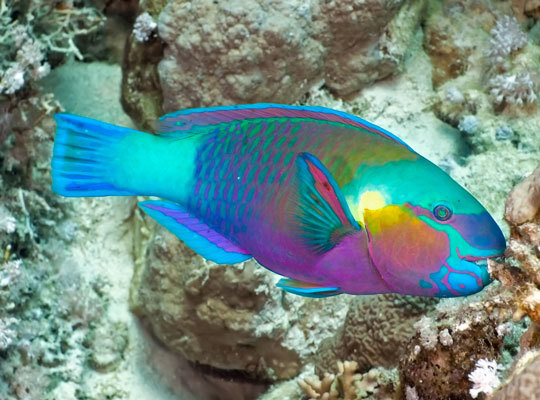
Amazing Facts about Parrotfish
First let's take a look at the parrotfish's beak. Recent research has shown that parrotfish have some of the strongest teeth in the world. They really need these strong teeth because they spend much of their time munching on coral and chewing algae off the rocks. They don't actually consume the hard calcium carbonate coral rock, but they chew it up to get the polyps—the soft-bodied coral animals—and to get the algae that live inside the polyps, as well as bacteria living on the coral rocks.
To be able to do this all day, parrotfish need amazingly hard teeth. Their teeth are actually made up of a material called fluorapatite, which has a striking crystalline structure. Fluorapatite is a biomineral (a mineral produced by living organisms), and it is the second-hardest biomineral known. In fact, a single square inch of parrotfish teeth can tolerate 530 tons of pressure without breaking. In case you're wondering, this is the the weight of about 88 elephants.
Check out this parrotfish beak. Sticking your finger in this fish's mouth would not be a good idea.

Not only are parrotfish teeth astoundingly strong, their configuration is unique. Each parrotfish had about 1,000 teeth. They are arranged in rows (up to 15 rows), and they are fused together to form a solid beak. When one row of teeth wears out, it simply falls out, and the next row back becomes the primary chewing row.
Check out this video of feeding parrotfish.
Because parrotfish chomp a lot of coral rock to get at the food it contains, they have to get rid of all that rock. Well, they poop most of it out as coral sand. First, they pulverize it with grinding teeth in their throats to get the goodies out of it, then the small bits pass through their body and are pooped out. A heavybeak parrotfish can produce about 2000 pounds (907 kg) of coral sand each year!
They excrete so much of the stuff that, over time, it can pile up until it creates an island. Eventually, the island will accumulate organic matter until plants begin to grow. If you have ever been to a tropical coral island and enjoyed relaxing on a beautiful white-sand coral beach, that sand is actually parrotfish poop.

Parrotfish have unusual and diverse life cycles. Most of the species are what we call sequential hermaphrodites. They start their lives as females then eventually turn into males. Along with this sex change, there is usually a dramatic change in color, as the males are often more brightly colored than the females.
Weird, huh? Let's dig a little deeper. Parrotfish tend to swim around in schools that form when the group is fairly young (and therefore female). When the females in the school reach sexual maturity, the largest female in the group will transform into a male. That male then becomes the one responsible for fertilizing the eggs of the females in his school.
To give you an idea of how different the colors can be, below is a female common parrotfish (on the left) and a male common parrotfish (on the right).

There are all kinds of variations of this among parrotfish species. In some species, like the stoplight parrotfish, some of the fish start out as males, but others start out as females and later turn into males. In one species, the marbled parrotfish, the fish do not change their gender at all (the only species that doesn't). In some species the female is brightly colored and the male is dull. In many species the juveniles of both sexes are a different color from the adults of both sexes.
As you can imagine, these various colors make it rather difficult to identify species. In fact, when scientists first started studying parrotfish, they identified over 350 different species, which is almost four times more than the actual number of species!
Below is a blunthead parrotfish.
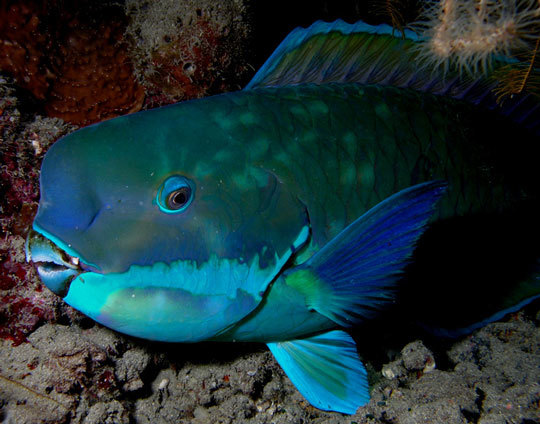
So, the Parrotfish deserves a place in the A.A.H.O.F.
(A-okay Animal Hall of Fame).
FUN FACT: The word A-okay (or A-OK) originated in 1952, when it was used in an ad for Midvac Steels (the ad said, "A-OK for tomorrow's missile demands"). However, it didn't become popular until people at NASA started using it in 1961. The term was commonly used to specify that everything checked out. It could be an abbreviation of "All systems are OK." The word is still widely used today, and it generally means "Ok, perfect, or excellent."
So, A-okay is another way to say awesome!
Photo Credits:
Queen parrotfish #1 - DepositPhotos
Parrotfish beak - DepositPhotoes
Coral Sand Island - Depositphotos
Female common parrotfish - Philippe Bourjon, CC BY-SA 3.0 via Wikimedia Commons
Male common parrotfish - Philippe Bourjon, CC BY-SA 3.0 via Wikimedia Commons
Blunthead parrotfish - Nhobgood, CC BY-SA 3.0 via Wikimedia Commons
What the heck is a Parrotfish?
Parrotfish make up a family (Scaridae) with about 95 species. Many of them sport amazingly bright colors. They live primarily in coral reefs but can also be found in seagrass beds. The name parrotfish comes from their parrot-like beak, which they use to scrape algae from coral and rock surfaces, and often they actually bite off chunks of coral.
Below is a queen parrotfish (I think).

Amazing Facts about Parrotfish
First let's take a look at the parrotfish's beak. Recent research has shown that parrotfish have some of the strongest teeth in the world. They really need these strong teeth because they spend much of their time munching on coral and chewing algae off the rocks. They don't actually consume the hard calcium carbonate coral rock, but they chew it up to get the polyps—the soft-bodied coral animals—and to get the algae that live inside the polyps, as well as bacteria living on the coral rocks.
To be able to do this all day, parrotfish need amazingly hard teeth. Their teeth are actually made up of a material called fluorapatite, which has a striking crystalline structure. Fluorapatite is a biomineral (a mineral produced by living organisms), and it is the second-hardest biomineral known. In fact, a single square inch of parrotfish teeth can tolerate 530 tons of pressure without breaking. In case you're wondering, this is the the weight of about 88 elephants.
Check out this parrotfish beak. Sticking your finger in this fish's mouth would not be a good idea.

Not only are parrotfish teeth astoundingly strong, their configuration is unique. Each parrotfish had about 1,000 teeth. They are arranged in rows (up to 15 rows), and they are fused together to form a solid beak. When one row of teeth wears out, it simply falls out, and the next row back becomes the primary chewing row.
Check out this video of feeding parrotfish.
Because parrotfish chomp a lot of coral rock to get at the food it contains, they have to get rid of all that rock. Well, they poop most of it out as coral sand. First, they pulverize it with grinding teeth in their throats to get the goodies out of it, then the small bits pass through their body and are pooped out. A heavybeak parrotfish can produce about 2000 pounds (907 kg) of coral sand each year!
They excrete so much of the stuff that, over time, it can pile up until it creates an island. Eventually, the island will accumulate organic matter until plants begin to grow. If you have ever been to a tropical coral island and enjoyed relaxing on a beautiful white-sand coral beach, that sand is actually parrotfish poop.

Parrotfish have unusual and diverse life cycles. Most of the species are what we call sequential hermaphrodites. They start their lives as females then eventually turn into males. Along with this sex change, there is usually a dramatic change in color, as the males are often more brightly colored than the females.
Weird, huh? Let's dig a little deeper. Parrotfish tend to swim around in schools that form when the group is fairly young (and therefore female). When the females in the school reach sexual maturity, the largest female in the group will transform into a male. That male then becomes the one responsible for fertilizing the eggs of the females in his school.
To give you an idea of how different the colors can be, below is a female common parrotfish (on the left) and a male common parrotfish (on the right).

There are all kinds of variations of this among parrotfish species. In some species, like the stoplight parrotfish, some of the fish start out as males, but others start out as females and later turn into males. In one species, the marbled parrotfish, the fish do not change their gender at all (the only species that doesn't). In some species the female is brightly colored and the male is dull. In many species the juveniles of both sexes are a different color from the adults of both sexes.
As you can imagine, these various colors make it rather difficult to identify species. In fact, when scientists first started studying parrotfish, they identified over 350 different species, which is almost four times more than the actual number of species!
Below is a blunthead parrotfish.

So, the Parrotfish deserves a place in the A.A.H.O.F.
(A-okay Animal Hall of Fame).
FUN FACT: The word A-okay (or A-OK) originated in 1952, when it was used in an ad for Midvac Steels (the ad said, "A-OK for tomorrow's missile demands"). However, it didn't become popular until people at NASA started using it in 1961. The term was commonly used to specify that everything checked out. It could be an abbreviation of "All systems are OK." The word is still widely used today, and it generally means "Ok, perfect, or excellent."
So, A-okay is another way to say awesome!
Photo Credits:
Queen parrotfish #1 - DepositPhotos
Parrotfish beak - DepositPhotoes
Coral Sand Island - Depositphotos
Female common parrotfish - Philippe Bourjon, CC BY-SA 3.0 via Wikimedia Commons
Male common parrotfish - Philippe Bourjon, CC BY-SA 3.0 via Wikimedia Commons
Blunthead parrotfish - Nhobgood, CC BY-SA 3.0 via Wikimedia Commons
Published on March 30, 2021 10:27
March 17, 2021
Awesome Animal - Sun Bear
It occurred to me that I have never featured a bear as the Awesome Animal. That ends today! I decided to choose a bear that is unusual and that some people may not be aware of. Let's take a look at the Sun Bear, the smallest of the world's eight bear species!
What the heck is a Sun Bear?
Sun bears, sometimes called Malayan sun bears or honey bears, live in Southeast Asia, including southern China into India, and south into Indonesia. They are smaller than other bears, weighing only 55 to 143 pounds (25 to 65 kg). This is only about half the size of an American black bear. They get the name sun bear from the yellow or cream-colored patch of fur on the chest. Legend has it that this patch represents the rising sun. Their small size helps them climb trees, and they are the most arboreal of all the bears. In fact, they even sleep in trees.
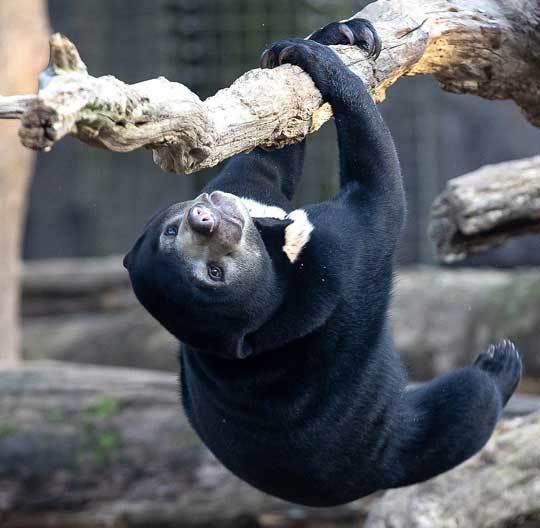
Amazing Facts about Sun Bears
Basindo nan tenggil. That's what sun bears are called in the Malay language. It means "he who likes to sit high." This is an ideal name for a bear that spends so much time up in trees. To help them climb, sun bears have really long claws, about 4 inches (10 cm) long! Also, the palms of their paws are hairless, to help them hold on to branches, and they have powerful legs for climbing.
Other bears have longer snouts and eyes that face out to the sides. Sun bears have short snouts and eyes that face forward. Forward-facing eyes allow better depth perception, which really helps when you're climbing around in trees.
Sun bears sometimes make sleeping nests high in the trees by gathering branches and leaves and arranging them into a comfy platform.
They live in tropical forests, and their short fur helps them stay cool. Because of their short hair and head shape, sun bears have earned the nickname dog bear.
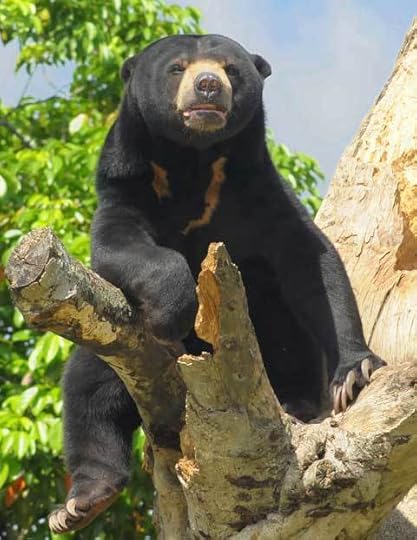
Sun bears are omnivores, which means they eat a wide variety of different foods. Their menu list includes termites, ants, bees (and of course honey), beetles, seeds, nuts, and fruits. They seem to love figs and often consume an impressive number of them at once. To help them slurp up bees, honey, and termites, sun bears have really long tongues, usually about ten inches (25 cm).
Check out this fun video, which shows the sun bear's long tongue in action, as well as its climbing skills, and more.
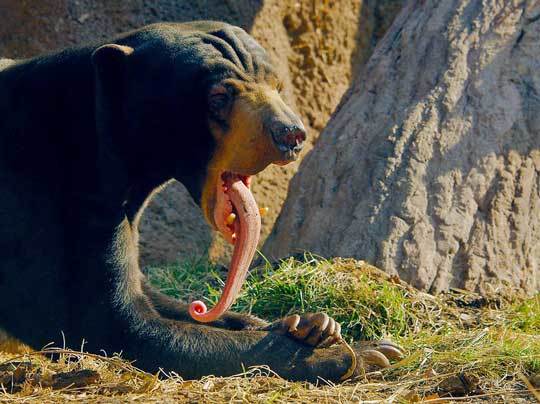
If some of these photos remind you of a wrinkled-skinned Shar Pei dog, that's because the sun bear has similarly wrinkled and loose skin. Why? This is a defense against predators. If a predator (such as a tiger) grabs hold of a sun bear, the loose skin allows the bear to move enough to turn and bite the predator to escape. Sun bears have powerful jaws and are very capable of defending themselves.
Sun bears are elusive, and little is known of their reproductive habits in the wild. In fact, we don't even know how long their pregnancies last. Some reports claim they are pregnant for only 95 days, others claim they are pregnant for as long as 240 days!
Here's what we do know. There is no distinct breeding season, and females can give birth any time during the year (they are the only bears that can do this). This characteristic is probably because they live in tropical areas, without a distinctly cold season.
Motherhood is a big job for female sun bears. They usually give birth to one or two cubs in a hollow tree. The cubs weigh only about 11 ounces (311 grams). These tiny newborns cannot hear, and their eyes are not open. In fact, their eyes remain closed for for 25 days. Once their eyes finally open, they are still blind until 50 days after being born. They don't even start running around and playing until four to five months. Then the babies stay with the mother for almost three years.
As you can probably imagine, baby sun bears are rather cute.
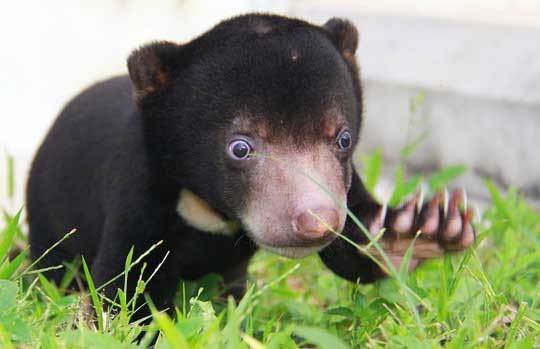
Unfortunately, sun bear numbers have declined drastically in recent decades. They are hard to find in the wild, so we aren't sure of their exact numbers. This lack of data prevents them from being listed as endangered, but scientists are sure their numbers are dwindling. The main reasons? Farming and logging have resulted in massive losses of their habitat. Also, poachers hunt them for meat and for body parts used in traditional medicine. Their gall bladders are commonly taken and sold for the bile. However, scientists have found no evidence that using the bile has any real benefit to humans. Sometimes mother sun bears are shot, and the babies are then taken and sold as pets.
The good news is, as we learn more about sun bears, more research-based efforts are being made to insure they have a future.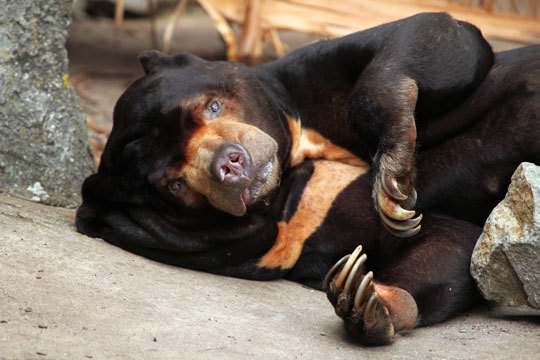
So, the Sun Bear deserves a place in the S.A.H.O.F.
(Stupendous Animal Hall of Fame).
FUN FACT: The word stupendous has been around for a while. It was first used in the early 1600s, and was derived from the Latin stupendus, meaning "to be wondered at." Today, stupendous is defined as "causing astonishment or wonder." Example: The Grand Canyon has some stupendous hiking trails. Another definition of stupendous is "of amazing size or greatness." Example: They are a family of stupendous wealth.
So, stupendous is another way to say awesome!
Photo Credits:
Sun bear hanging upside down - Wikimedia Commons, Theo Kruse Burgers' Zoo, CC BY-SA 4.0
Sun bear in tree - Ucumari photography. CC BY-NC-ND 2.0
Sun bear tongue - guppiecat. CC BY-NC-ND 2.0
Sun bear baby - San Diego Zoo
Sun bear lounging in zoo - DepositPhotos
What the heck is a Sun Bear?
Sun bears, sometimes called Malayan sun bears or honey bears, live in Southeast Asia, including southern China into India, and south into Indonesia. They are smaller than other bears, weighing only 55 to 143 pounds (25 to 65 kg). This is only about half the size of an American black bear. They get the name sun bear from the yellow or cream-colored patch of fur on the chest. Legend has it that this patch represents the rising sun. Their small size helps them climb trees, and they are the most arboreal of all the bears. In fact, they even sleep in trees.

Amazing Facts about Sun Bears
Basindo nan tenggil. That's what sun bears are called in the Malay language. It means "he who likes to sit high." This is an ideal name for a bear that spends so much time up in trees. To help them climb, sun bears have really long claws, about 4 inches (10 cm) long! Also, the palms of their paws are hairless, to help them hold on to branches, and they have powerful legs for climbing.
Other bears have longer snouts and eyes that face out to the sides. Sun bears have short snouts and eyes that face forward. Forward-facing eyes allow better depth perception, which really helps when you're climbing around in trees.
Sun bears sometimes make sleeping nests high in the trees by gathering branches and leaves and arranging them into a comfy platform.
They live in tropical forests, and their short fur helps them stay cool. Because of their short hair and head shape, sun bears have earned the nickname dog bear.

Sun bears are omnivores, which means they eat a wide variety of different foods. Their menu list includes termites, ants, bees (and of course honey), beetles, seeds, nuts, and fruits. They seem to love figs and often consume an impressive number of them at once. To help them slurp up bees, honey, and termites, sun bears have really long tongues, usually about ten inches (25 cm).
Check out this fun video, which shows the sun bear's long tongue in action, as well as its climbing skills, and more.

If some of these photos remind you of a wrinkled-skinned Shar Pei dog, that's because the sun bear has similarly wrinkled and loose skin. Why? This is a defense against predators. If a predator (such as a tiger) grabs hold of a sun bear, the loose skin allows the bear to move enough to turn and bite the predator to escape. Sun bears have powerful jaws and are very capable of defending themselves.
Sun bears are elusive, and little is known of their reproductive habits in the wild. In fact, we don't even know how long their pregnancies last. Some reports claim they are pregnant for only 95 days, others claim they are pregnant for as long as 240 days!
Here's what we do know. There is no distinct breeding season, and females can give birth any time during the year (they are the only bears that can do this). This characteristic is probably because they live in tropical areas, without a distinctly cold season.
Motherhood is a big job for female sun bears. They usually give birth to one or two cubs in a hollow tree. The cubs weigh only about 11 ounces (311 grams). These tiny newborns cannot hear, and their eyes are not open. In fact, their eyes remain closed for for 25 days. Once their eyes finally open, they are still blind until 50 days after being born. They don't even start running around and playing until four to five months. Then the babies stay with the mother for almost three years.
As you can probably imagine, baby sun bears are rather cute.

Unfortunately, sun bear numbers have declined drastically in recent decades. They are hard to find in the wild, so we aren't sure of their exact numbers. This lack of data prevents them from being listed as endangered, but scientists are sure their numbers are dwindling. The main reasons? Farming and logging have resulted in massive losses of their habitat. Also, poachers hunt them for meat and for body parts used in traditional medicine. Their gall bladders are commonly taken and sold for the bile. However, scientists have found no evidence that using the bile has any real benefit to humans. Sometimes mother sun bears are shot, and the babies are then taken and sold as pets.
The good news is, as we learn more about sun bears, more research-based efforts are being made to insure they have a future.

So, the Sun Bear deserves a place in the S.A.H.O.F.
(Stupendous Animal Hall of Fame).
FUN FACT: The word stupendous has been around for a while. It was first used in the early 1600s, and was derived from the Latin stupendus, meaning "to be wondered at." Today, stupendous is defined as "causing astonishment or wonder." Example: The Grand Canyon has some stupendous hiking trails. Another definition of stupendous is "of amazing size or greatness." Example: They are a family of stupendous wealth.
So, stupendous is another way to say awesome!
Photo Credits:
Sun bear hanging upside down - Wikimedia Commons, Theo Kruse Burgers' Zoo, CC BY-SA 4.0
Sun bear in tree - Ucumari photography. CC BY-NC-ND 2.0
Sun bear tongue - guppiecat. CC BY-NC-ND 2.0
Sun bear baby - San Diego Zoo
Sun bear lounging in zoo - DepositPhotos
Published on March 17, 2021 18:14
February 27, 2021
Awesome Animal - Glass Frog
There's a scene in my novel Hostile Emergence in which the characters are trying to make sense of something strange that they saw—beings that appeared to be translucent. They wonder if the beings' see-through nature was due to translucent body tissues, like glass frogs and some fish (it wasn't). Anyway, a see-through frog? Is that really possible? And why?
What the heck is a Glass Frog?
Glass frogs include about 150 species belonging to the family Centrolenidae. They live in the rainforests of Central and South America. Most of these frogs are lime green when viewed from above, but their bellies and legs can be astoundingly transparent in such a way that the internal organs and bones are clearly visible. There are some aquatic animals that are transparent, but glass frogs are the only land animals with transparent skin (although some insects have transparent wings, but that doesn't really count).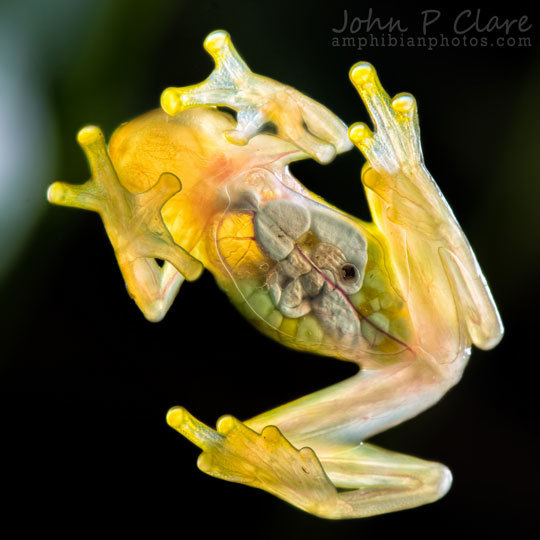
Amazing Facts about Glass Frogs
Okay, first we need to figure out why these frogs have transparent bellies. Is it just a coincidence that their skin is transparent, or does this characteristic somehow benefit the frog?
Scientists have long debated this question, but it wasn't until 2020 that a study finally provided a good explanation. It's a unique form of camouflage called edge diffusion.
First, a bit of background information. There are generally two types of animal camouflage. First, there is background matching, in which the animal looks similar to its background, thus blending in. Second, there is disruptive coloration, in which the animal has a certain high-contrast pattern that hides the animal's shape. A common example of disruptive coloration is a dark stripe that runs across an animals eye, making the eye difficult to see (eyes are often what give away an animal's presence).
Normally you might think being transparent would be a good way to achieve background matching, right? However, glass frogs' backs are not transparent, and they usually hold their transparent belly against a leaf, like this:

So, what's the point of being transparent only on the ventral side? How does this help the frog hide? Well, as it turns out, a glass frog's legs are usually more translucent than its head and back. When the frog is hiding on a leaf (as in the photo above), it tucks its four legs against its sides. Since these legs are usually translucent, this makes the edges of the frog blend in with the leaf. When the edges of an animal blend in, this makes it harder for a predator to pick out the animal's outline. This is called edge diffusion, and it tends to work well on a variety of different backgrounds because the frog does not have to change colors to match the color of the leaf.
Scientists in the study created 360 fake frogs out of gelatin, and they placed them on leaves in the rainforest for three days. Half the gelatin frogs had translucent legs tucked against their sides, the other half had opaque legs. Birds attacked the opaque-legged frogs twice as frequently as the translucent-legged frogs.
The transparent belly of glass frogs may simply be a side effect of having transparent legs. The photo below does a nice job of showing how translucent the glass frog's legs can be. These translucent legs allow the frog to use edge diffusion as a form of camouflage.

No other land animals can use transparency to achieve edge diffusion as a form of camouflage, which makes glass frogs very unique!
Many glass frogs have spectacular eyes, which might also help to break up their outline. An amazing example is the pretty-eyed frog:

We also need to talk about glass frog reproduction. Glass frogs live almost their entire lives among the leaves of rainforest trees. During the breeding season they move to trees that hang over rivers and streams. When a female is ready to lay eggs, a male will latch onto her (a behavior called amplexus), and he will not let go until she lays her eggs. The male then fertilizes the eggs as they are being laid.
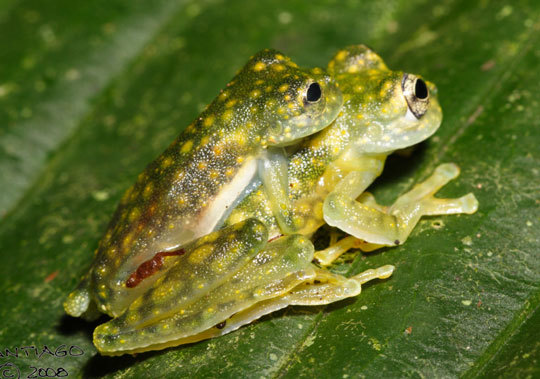
Here's where things get kind of unusual. Most frogs lay their eggs in water and then leave the eggs alone, never seeing them again. Glass frogs, however, paste their eggs directly to the top or underside of a leaf high above a stream or river.
To reduce the chances of the eggs being eaten by predators, in many glass frog species, the female takes off on her own, while the male stays behind to protect the eggs until they hatch. The guardian male becomes extremely aggressive toward anything that comes near the eggs, often kicking at the intruder ninja-style.
Check out this fun video about male glass frogs protecting their eggs from wasp predators.

If the male is successful in protecting the eggs until they hatch, the baby frogs will pop out of the eggs and fall from the tree into the stream or river below. Of course, there they have numerous other predators to avoid, but such is the life of a frog!
So, the Glass Frog deserves a place in the S.A.H.O.F.
(Swell Animal Hall of Fame).
FUN FACT: The word swell has several meanings. As a noun, it refers to a type of wave where the water rises abruptly, or to a rounded elevation of land. As a verb, it refers to something expanding in size. In about 1810 people started using it as an adjective, describing something or someone as stylish or fashionably dressed. Finally, in about 1930, people began using it as an adjective to describe something as good or excellent. Example: "That was a swell party." It was also used as a standalone adjective to express satisfaction: "Swell!" (kind of like "Cool!").
So, swell is another way to say awesome!
Photo Credits:
Glass frog #1 - Seánín Óg via Creative Commons
Glass frog on leaf - lwolfartist via Creative Commons
Pretty-eyed frog - Santiago Ron via Creative Commons
Glass frogs in amplexus - Santiago Ron via Creative Commons
Male glass frog protecting eggs - DepositPhotos
Transparent glass frog #2 - DepositPhotos
What the heck is a Glass Frog?
Glass frogs include about 150 species belonging to the family Centrolenidae. They live in the rainforests of Central and South America. Most of these frogs are lime green when viewed from above, but their bellies and legs can be astoundingly transparent in such a way that the internal organs and bones are clearly visible. There are some aquatic animals that are transparent, but glass frogs are the only land animals with transparent skin (although some insects have transparent wings, but that doesn't really count).

Amazing Facts about Glass Frogs
Okay, first we need to figure out why these frogs have transparent bellies. Is it just a coincidence that their skin is transparent, or does this characteristic somehow benefit the frog?
Scientists have long debated this question, but it wasn't until 2020 that a study finally provided a good explanation. It's a unique form of camouflage called edge diffusion.
First, a bit of background information. There are generally two types of animal camouflage. First, there is background matching, in which the animal looks similar to its background, thus blending in. Second, there is disruptive coloration, in which the animal has a certain high-contrast pattern that hides the animal's shape. A common example of disruptive coloration is a dark stripe that runs across an animals eye, making the eye difficult to see (eyes are often what give away an animal's presence).
Normally you might think being transparent would be a good way to achieve background matching, right? However, glass frogs' backs are not transparent, and they usually hold their transparent belly against a leaf, like this:

So, what's the point of being transparent only on the ventral side? How does this help the frog hide? Well, as it turns out, a glass frog's legs are usually more translucent than its head and back. When the frog is hiding on a leaf (as in the photo above), it tucks its four legs against its sides. Since these legs are usually translucent, this makes the edges of the frog blend in with the leaf. When the edges of an animal blend in, this makes it harder for a predator to pick out the animal's outline. This is called edge diffusion, and it tends to work well on a variety of different backgrounds because the frog does not have to change colors to match the color of the leaf.
Scientists in the study created 360 fake frogs out of gelatin, and they placed them on leaves in the rainforest for three days. Half the gelatin frogs had translucent legs tucked against their sides, the other half had opaque legs. Birds attacked the opaque-legged frogs twice as frequently as the translucent-legged frogs.
The transparent belly of glass frogs may simply be a side effect of having transparent legs. The photo below does a nice job of showing how translucent the glass frog's legs can be. These translucent legs allow the frog to use edge diffusion as a form of camouflage.

No other land animals can use transparency to achieve edge diffusion as a form of camouflage, which makes glass frogs very unique!
Many glass frogs have spectacular eyes, which might also help to break up their outline. An amazing example is the pretty-eyed frog:

We also need to talk about glass frog reproduction. Glass frogs live almost their entire lives among the leaves of rainforest trees. During the breeding season they move to trees that hang over rivers and streams. When a female is ready to lay eggs, a male will latch onto her (a behavior called amplexus), and he will not let go until she lays her eggs. The male then fertilizes the eggs as they are being laid.

Here's where things get kind of unusual. Most frogs lay their eggs in water and then leave the eggs alone, never seeing them again. Glass frogs, however, paste their eggs directly to the top or underside of a leaf high above a stream or river.
To reduce the chances of the eggs being eaten by predators, in many glass frog species, the female takes off on her own, while the male stays behind to protect the eggs until they hatch. The guardian male becomes extremely aggressive toward anything that comes near the eggs, often kicking at the intruder ninja-style.
Check out this fun video about male glass frogs protecting their eggs from wasp predators.

If the male is successful in protecting the eggs until they hatch, the baby frogs will pop out of the eggs and fall from the tree into the stream or river below. Of course, there they have numerous other predators to avoid, but such is the life of a frog!
So, the Glass Frog deserves a place in the S.A.H.O.F.
(Swell Animal Hall of Fame).
FUN FACT: The word swell has several meanings. As a noun, it refers to a type of wave where the water rises abruptly, or to a rounded elevation of land. As a verb, it refers to something expanding in size. In about 1810 people started using it as an adjective, describing something or someone as stylish or fashionably dressed. Finally, in about 1930, people began using it as an adjective to describe something as good or excellent. Example: "That was a swell party." It was also used as a standalone adjective to express satisfaction: "Swell!" (kind of like "Cool!").
So, swell is another way to say awesome!
Photo Credits:
Glass frog #1 - Seánín Óg via Creative Commons
Glass frog on leaf - lwolfartist via Creative Commons
Pretty-eyed frog - Santiago Ron via Creative Commons
Glass frogs in amplexus - Santiago Ron via Creative Commons
Male glass frog protecting eggs - DepositPhotos
Transparent glass frog #2 - DepositPhotos
Published on February 27, 2021 05:53



